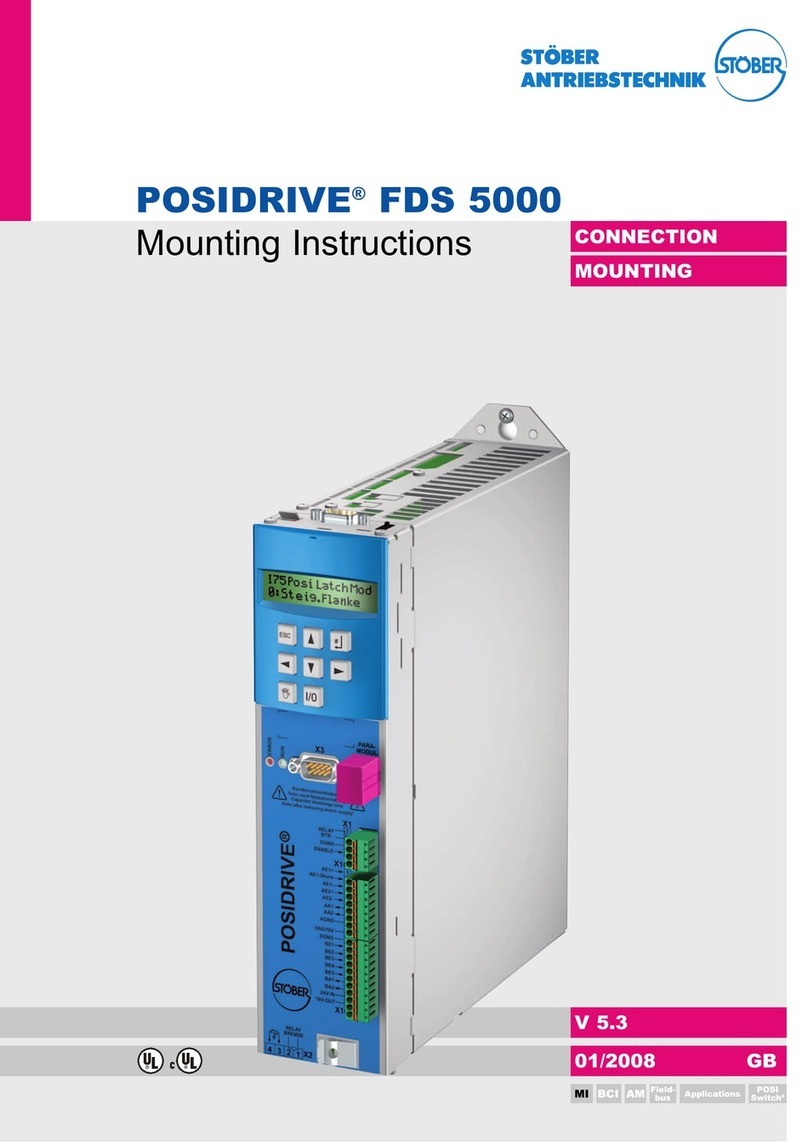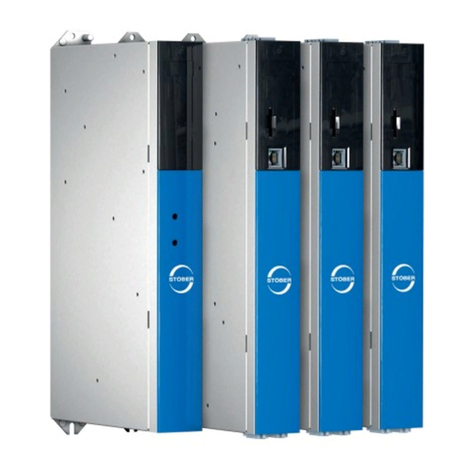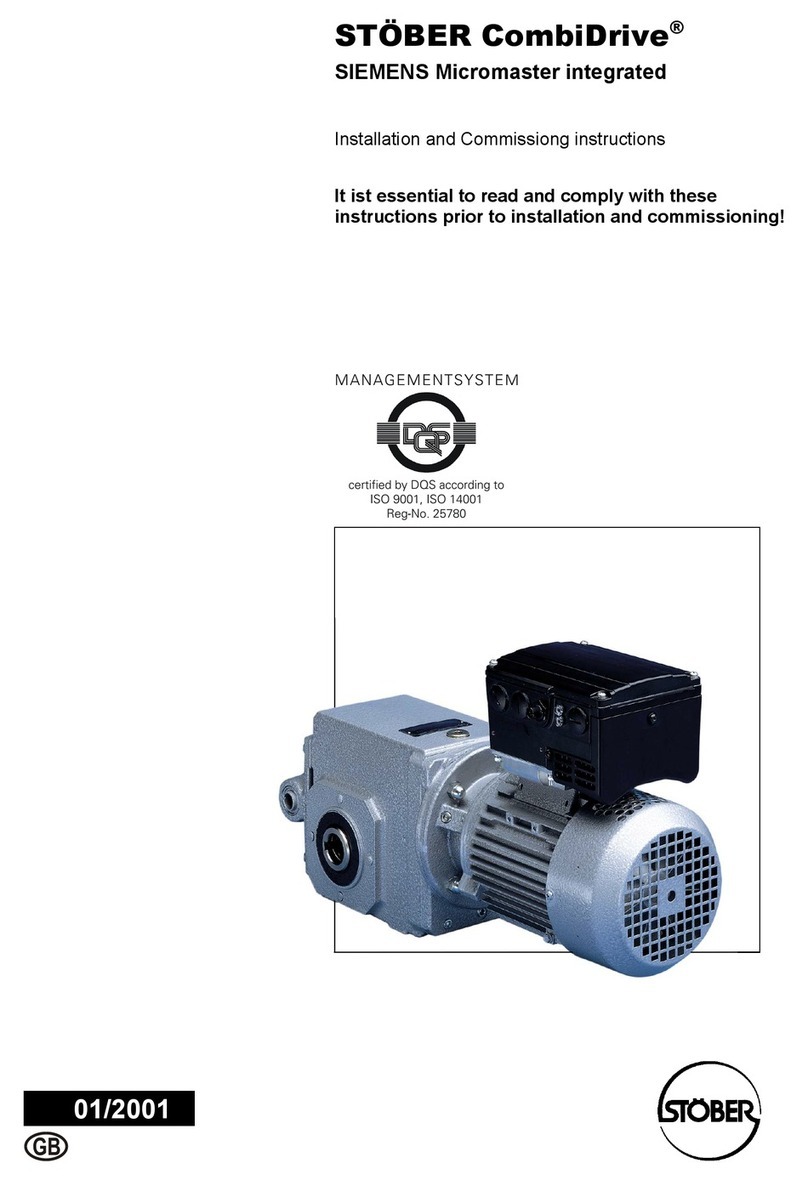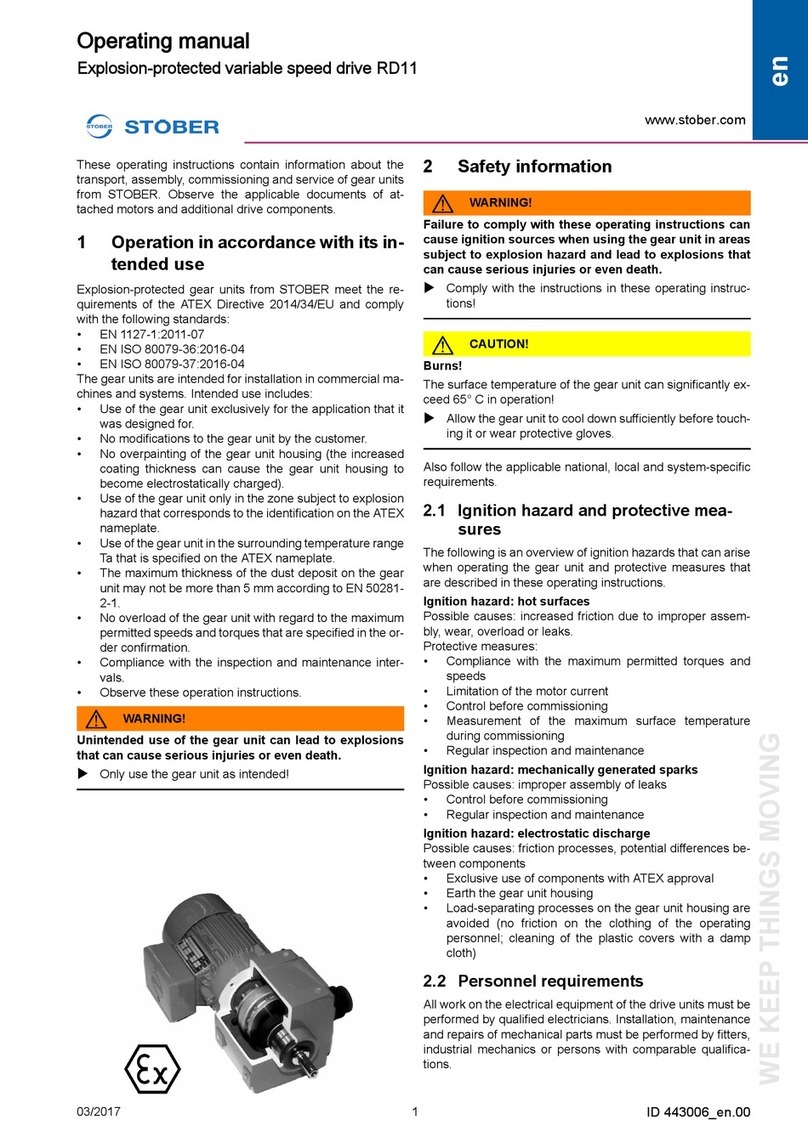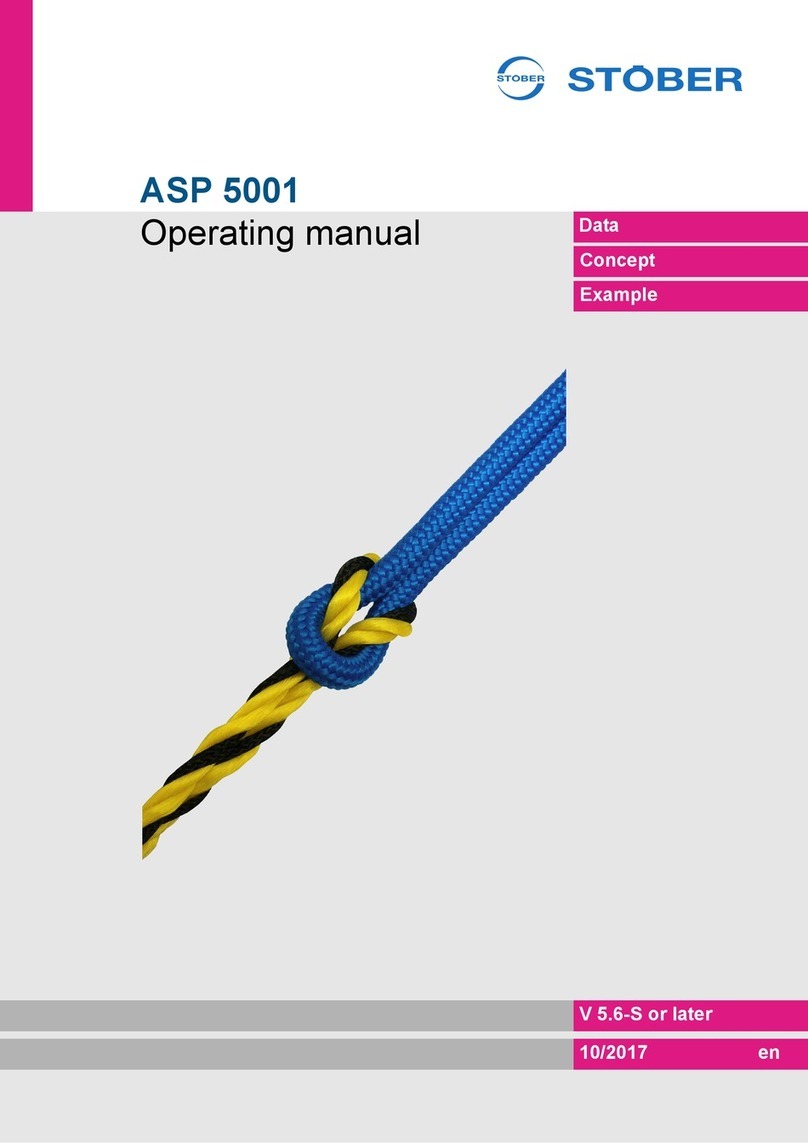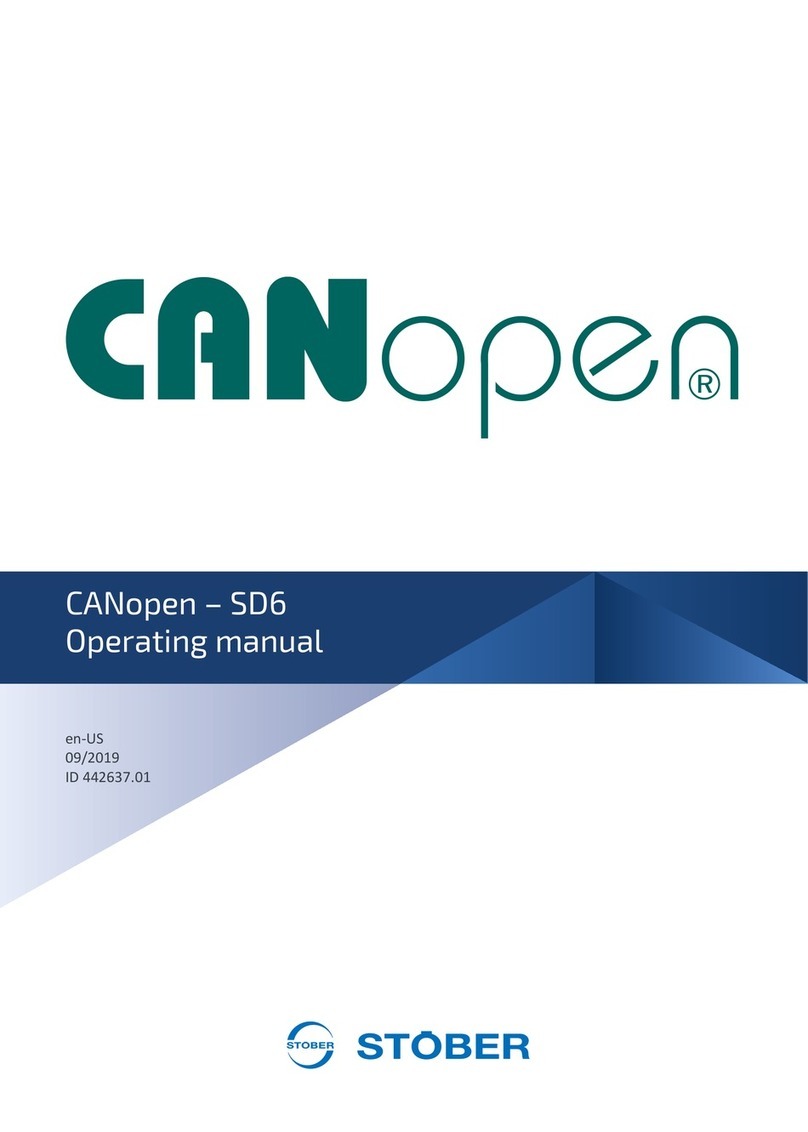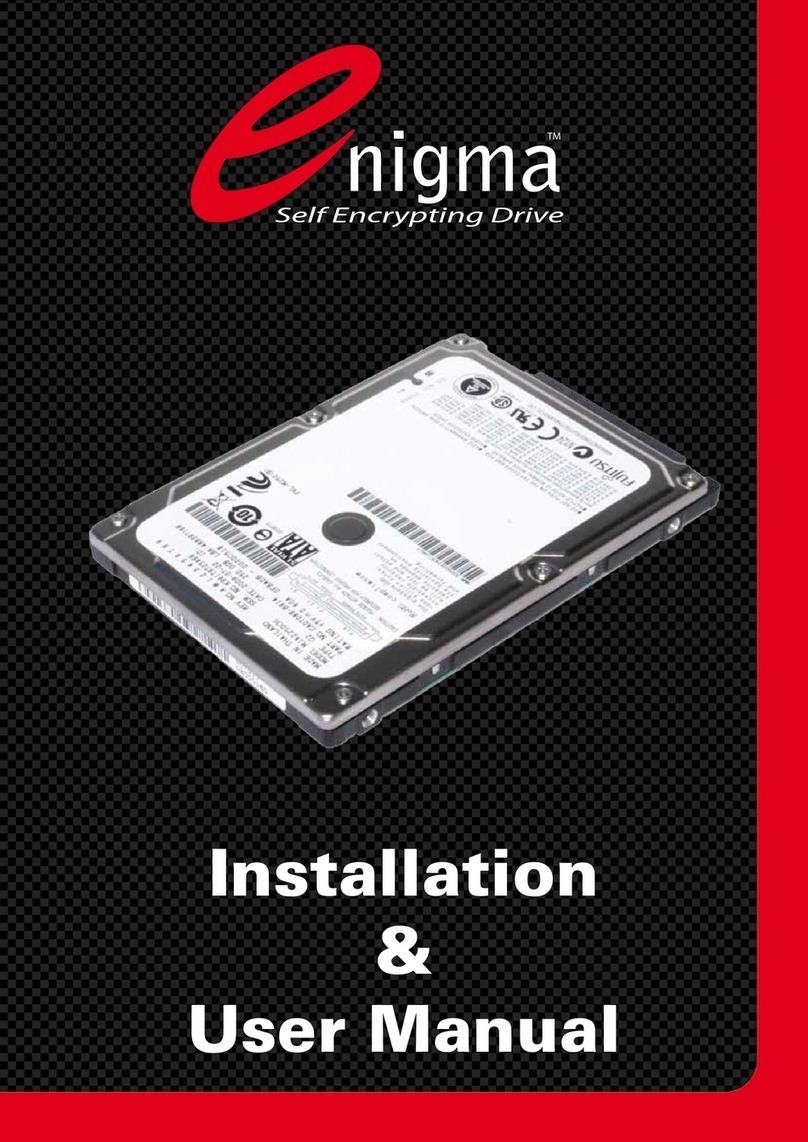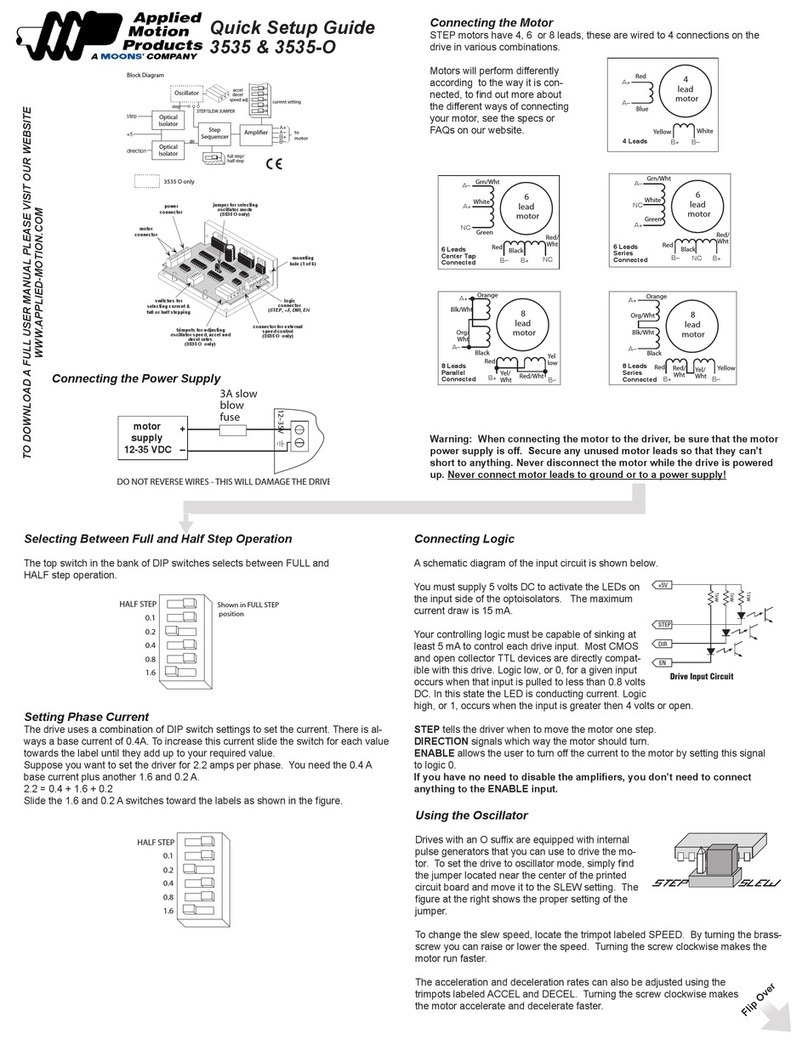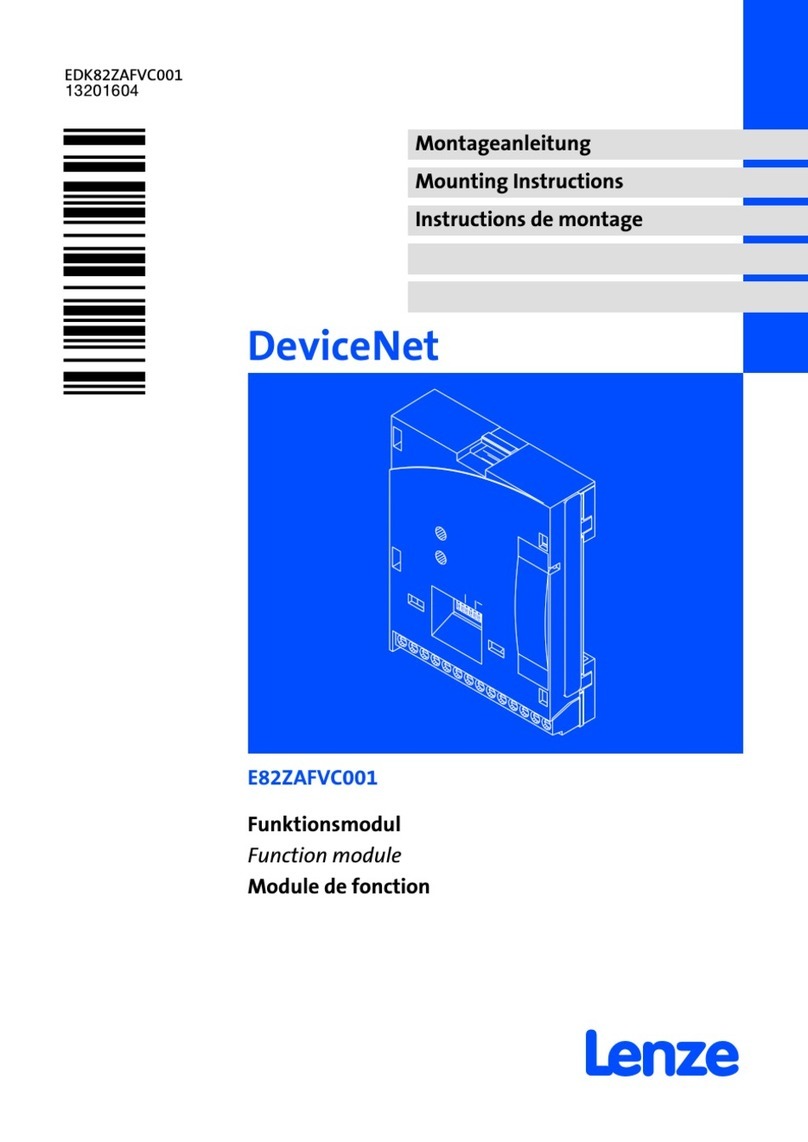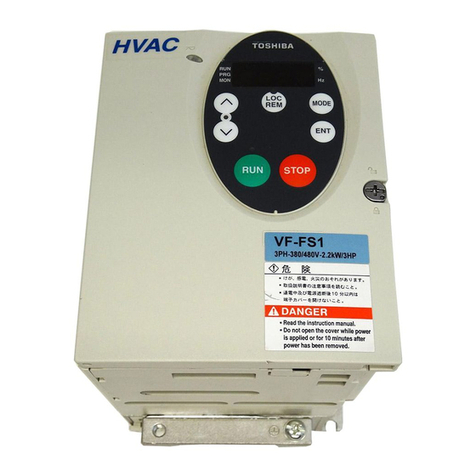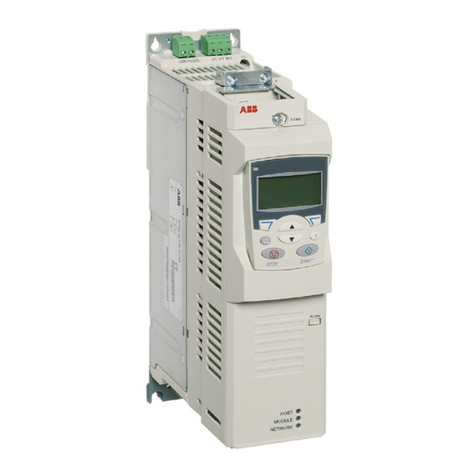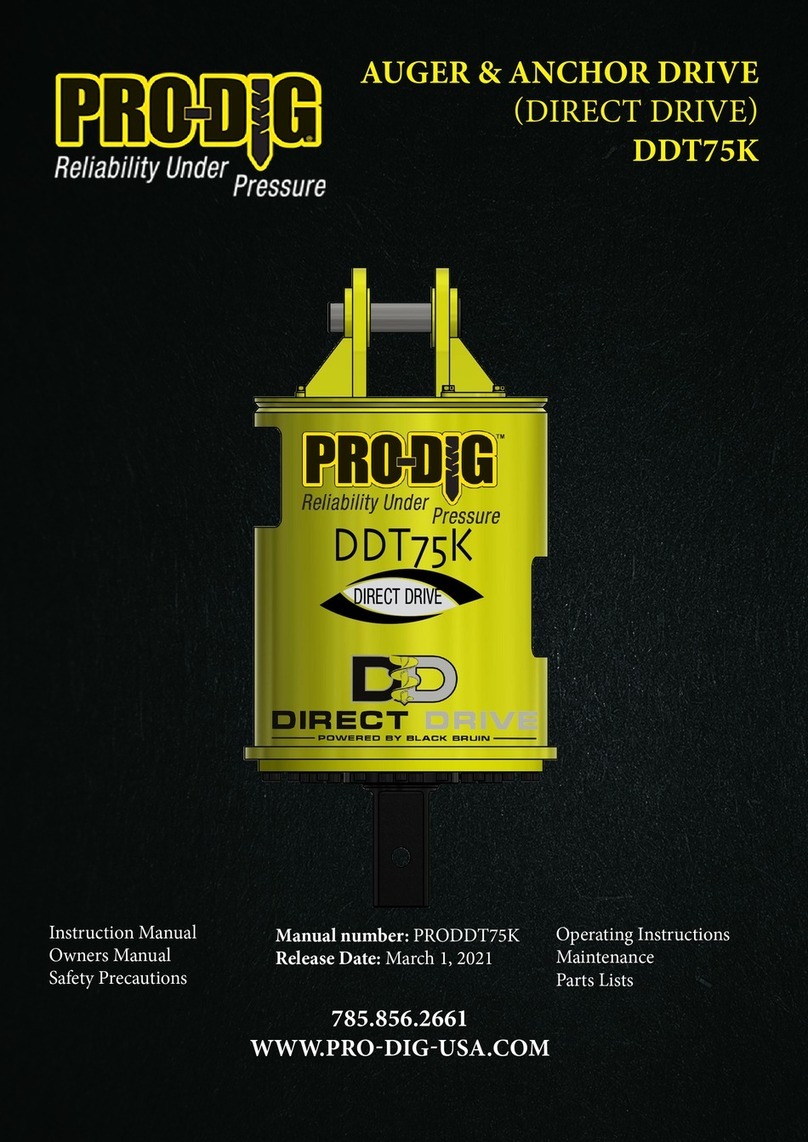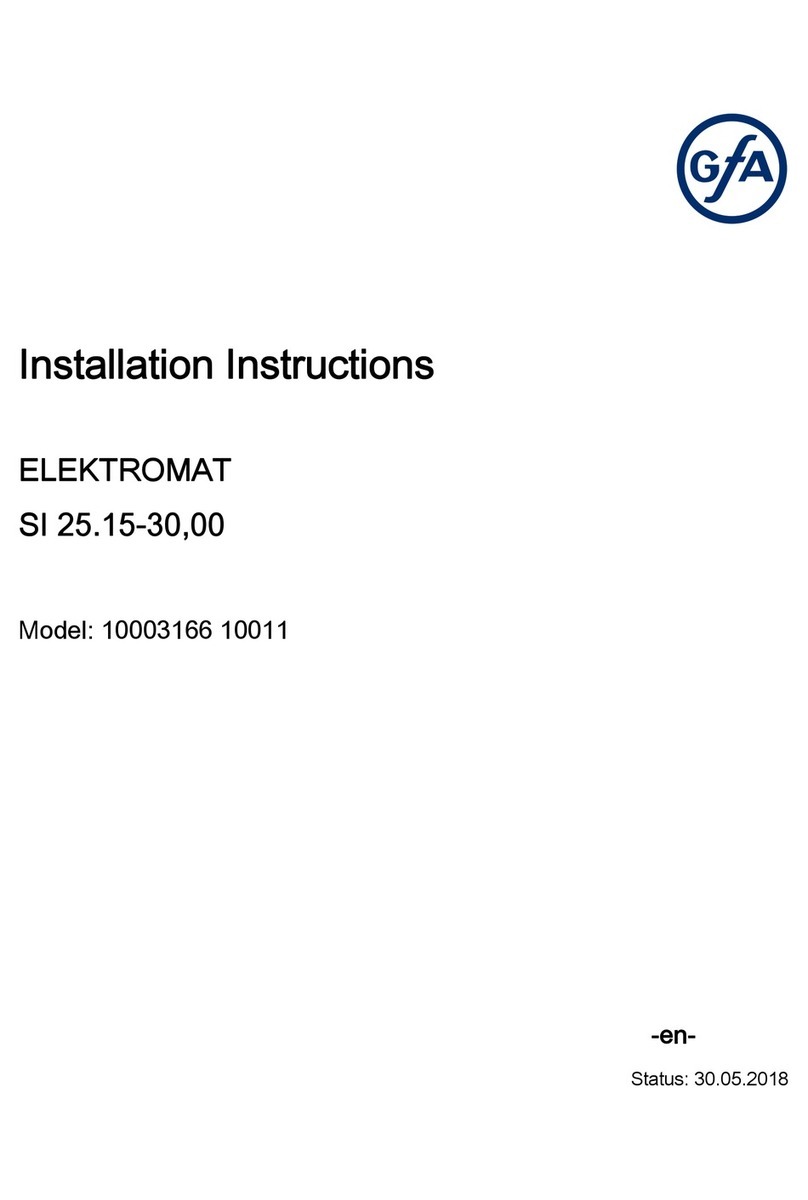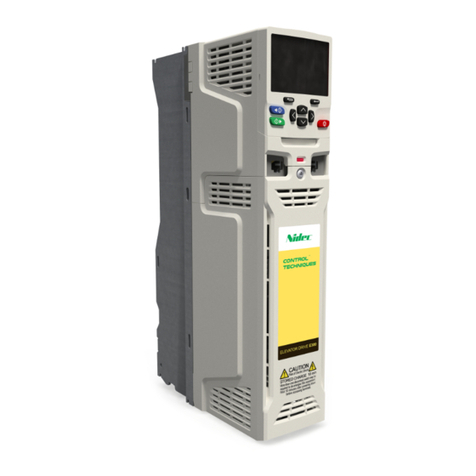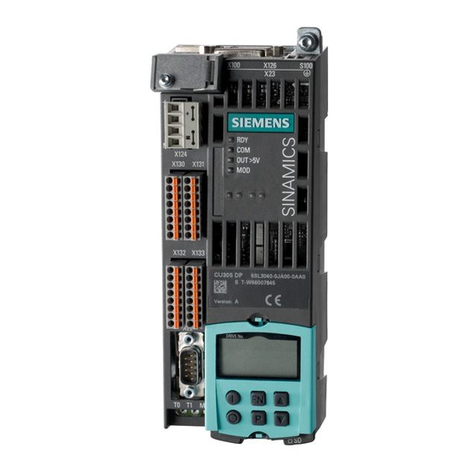Stober FDS 4000 Installation and operation manual

FREQUENCY INVERTER
POSIDRIVE
®
FDS 4000
Installation and Commissioning Instructions
It is essential to read and comply with these
instructions prior to installation and
commissioning.
SV. 4.5
07/2003
FDS
POSITIONING CONTROL
VECTOR CONTROL
SYNCHRONOUS
OPERATION
TECHNOLOGY
MANA
G
EMENT
S
Y
S
TE
M
certified by DQS according to
DIN EN ISO 9001, DIN EN ISO 14001
Reg-No. 000780 UM/Q
M

POSIDRIVE
®
FDS 4000
STÖBER
ANTRIEBSTECHNIK
Table of Contents
Table of Contents
1. Notes on Safety 1
2. Technical Specifications 2
3. Physical Installation 3
3.1 Installation Site 3
4. Electrical Installation 3
4.1 EMC-Compatible Installation 4
4.2 FI Circuit Breaker 4
4.3 DC Link Coupling 4
5. Conn. Assignment - Control Portion 5
6. Inverter Exchange, Compatibility 6
6.1 Option Boards EA4000, GB4000 6
6.2 FDS 1000, 2000 6
7. Operator Control and Programming 6
7.1 Status Indication 6
7.2 Parameterization 6
7.3 Password 7
8. Commissioning 7
8.1 Primary Parameters 7
8.2 Motor Type 7
8.3 Reference Value via Keyboard 8
8.4 Analog / Frequency Reference Value 8
8.5 Fixed Ref. Values (Digital Ref. Values) 8
8.6 Brake Control 8
8.7 Parameter Transmission 9
9. Special Functions 9
9.1 Binary Inputs BE1 to BE5 (BE6 to BE10) 9
9.2 Torque Limits 9
9.3 Operating Range 9
9.4 Parameter Record Selection 10
9.5 Motor Potentiometer 10
9.6 Speed Feedback 10
9.7 Acknowledgment of Faults 11
9.8 Motor Startup 11
9.9 Control via PC 11
10. Positioning Control 12
10.1 Function Overview 12
10.2 Connections 12
10.3 Destination Positioning and Proc. Blocks 13
10.4 Absolute / Relative Positioning 14
10.5 Commissioning 14
10.5.1 Limited Traversing Range 14
10.5.2 Continuous Trav. Range (Rotary Axis) 15
10.6 Reference Point Traversing 15
10.7 Position Controller 16
10.8 Process Block Chaining 16
10.9 Simple Examples 17
10.10 Emergency Off 18
10.11 Ext. Rotary / Linear Path Measurement 19
10.11.1 Encoder 19
10.11.2 Adjustment of Motor / Ext. Meas. System 19
10.11.3 External Encoder and Posi Parameters 19
10.12 Posi Switching Points 20
11. Technology 20
11.1 PID Controller 20
11.2 Winders 21
11.2.1 Diameter Sensor on AE1/AE2 21
11.2.2 Indirect Tension Control at M-Max Limit 21
11.2.3 Winding with Compensating Roller 22
11.2.4 Winding with Tension Sensor 22
11.2.5 Compensation of Fault Variables 22
12. Synchronous Running, El. Gearbox 22
12.1 Function Overview 22
12.2 Connection of Encoder 23
12.3 Connection of Inputs and Outputs 23
12.4 Commissioning of Slave 23
12.5 Angle Deviation 24
12.6 Angle and Speed Sync. Running 24
12.7 Emergency Off 24
12.8 Reference Point Traversing - Slave 24
13. Parameter Description 25
14. Option Boards 55
14.1 Option Board GB4001 and EA4001 55
14.2 Option Board Ext. 24 V Power Supply 56
14.3 Option Board SSI-4000 57
15. Result Table 58
16. Operating States 59
17. Faults/Events 60
18. Block Circuit Diagram - Sync. Running 62
19. Block Circuit Diagram - Ref. Val. Proc. 63
20. Parameter Table 64
21. Accessories 67
21.1 Accessories Overview 67
21.2 Braking Resistor 70
21.2.1 Allocation of Braking Resistor to FBS/FDS 70
21.2.2 Braking Resistor FZM/FZZM (Dimensions) 70
21.2.3 Braking Resistor VHPR (Dimensions) 71
21.3 Output Derating / Output Filter 71
21.3.1 Allocation of Output Derating / Output 71
Filter to FBS/FDS
21.3.2 Output Derating RU (Dimensions) 71
21.3.3 Output Filter MF (Dimensions) 71

POSIDRIVE
®
FDS 4000
STÖBER
ANTRIEBSTECHNIK
1. Notes on Safety
1
1NOTES ON SAFETY
To prevent avoidable problems from occurring during commissioning and/or operation, it is essential to
read and comply with this entire instruction manual before starting installation and commissioning.
Based on DIN EN 50178 (once VDE 0160), FBS/FDS-series frequency inverters are defined as electronic
power equipment (BLE) for the control of power flow in high-voltage systems. They are designed exclusively to
power three-phase-current, asynchronous machines. Handling, installation, operation and maintenance must be
performed in accordance with valid and/or legal regulations, applicable standards and this technical
documentation.
The frequency inverter are products of the restricted sales class (in accordance with IEC 61800-3. Use of this
products in residential areas may cause high-frequency interference in which case the user may be ordered to
take suitable measures.
The user must ensure strict adherence to these standards.
The safety notes and specifications stated in additional sections (items) must be adhered to by the user.
Caution! High touch voltage! Danger of electric shock! Danger of death!
Never under any circumstances may the housing be left open or connections disconnected when the power is
on. Disconnect the power plug of the frequency inverter and wait at least 5 minutes after the power voltage has
been switched off before opening the frequency inverter to install or remove option boards. Correct configuration
and installation of the inverter drive are prerequisites to correct operation of the frequency inverter. Only
appropriately qualified personnel may transport, install, commission and operate this device.
The frequency inverter must be installed in a switching cabinet which does not exceed the maximum ambient
temperature (see technical data).
Only copper wiring may be used. For use in the U.S.A., see table 310-16 of the National Electrical Code (NEC)
for line cross sections to be used at 60 °C or 75 °C.
STÖBER ANTRIEBSTECHNIK accepts no liability for damages caused by non-adherence to the
instructions or applicable regulations.
The motor must have an integral temperature monitoring device or external motor overload protection must be
used.
Only suitable for use on power networks which cannot supply more than a symmetric, nominal short-circuit
current of 5000 A at 240 V ac / 480 V ac.
Notes: Subject to technical changes for improvement of the devices without prior notice. This documentation
is solely a product description. It is not a promise of features in the sense of warranty rights.
Pay particular attention to the following:
•Permissible protection class: Protective ground; operation only permitted when protective
conductor is correctly connected. The devices may not be operated directly on IT networks.
•Installation work may only be performed in a voltage-free state. When work has to be done on the drive,
inhibit the enable and disconnect the complete drive from the power network. Adhere to the 5 safety
regulations.
•Discharge time of the DC link capacitors > 5 minutes
•Do not penetrate the interior of the device with any kind of object.
•When performing installation or other work in the switching cabinet, protect the device against falling
objects (e.g., pieces of wire, flexible leads, metal parts and so on). Conductive parts may cause short
circuiting or device failure on the frequency inverter.
•Before commissioning, remove all extra coverings to prevent the device from overheating.

POSIDRIVE
®
FDS 4000
STÖBER
ANTRIEBSTECHNIK
2. Technical Specifications
2
FDS 4300/B*
22 kW
3 x 44 A
3 x 63 AT
550 W
13.2
15.4
FDS 4270/B*
18.5 kW
3 x 39 A
3 x 50 AT
0 to +40 °C f. nom. data,
500 W
13
15.2
FDS 4220/B*
15 kW
3 x 32 A
3 x 50 AT
420 W
12.8
15
FDS 4150/B*
11 KW
3 x 22 A
3 x 35 AT
290 W
12.4
14.6
Model 3 / BG III
FDS 4110/B*
7.5 kW
3 x 16 A
3 x 25 AT
≥30 Ω;
max. 21 kW const.,
220 W
186 x 410 x 268
max. 10
12.3
14.5
FDS 4085/B*
5.5 kW
3 x 12 A
3 x 20 AT
180 W
FDS 4070/B*
4.0 kW
3 x 10 A
3 x 16 AT
150 W
FDS 4040/B*
2.2 kW
3 x 5.5 A
(L1-L3) 3 x 400 V
+28%/-55%
4)
/ 50/60 Hz
3 x 10 AT
88 W
Model 2 / BG II
FBS 4028/B*
1.5 kW
3 x 7.0 A
see
FBS / BGI
1 x 16 AT
≥100 Ω;
max. 1,28 kW const.,
max. 6,4 kW für 0,5 s
100 W
98 x 300 x 268
max. 4.0
5
6.4
FDS 4024/B*
1.5 kW
3 x 3.5 A
77 W
FDS 4014/B
0.75 kW
3 x 2.1 A
(L1-L3) 3 x 400 V
+28%/-55%
4)
/ 50/60 Hz
3 x 6 AT
≥200 Ω;
max. 640 W const.,
max. 3,2 kW für 1 s
50 W
FBS 4013/B
0.75 kW
3 x 3.5 A
1 x 10 AT
53 W
Model 1 / BG I
FBS 4008/B
0.37 kW
3 x 2.1 A
(L1-N) 1 x 230 V
+20%/-55%
4)
/ 50/60 Hz
1 x 6 AT
3 x 0 V up to connection
voltage
0 - 200 Hz (vector control: 0 - 100 Hz; spindles: 0 - 400 Hz at B20=0V/f-control and B24=8 kHz) / resolution of 0.01 Hz
200 % / 2 sec , 150 % / 30 sec
4 kHz (adjustable up to 16 kHz with current derating of 46% at 16 kHz, 75% at 8 kHz)
≥100 Ω;
max. 320 W const.,
max. 1,8 kW für 1 s
Integrated network filter for compliance with RFI suppression in acc. w. EN 55011, classes A + B/residential and industrial zoning
EN 61000 -4 -2, -3, -4, -5/residential and industrial zoning
50 m, proportionately shorter when several motors are used. Longer lengths or parallel installation to encoder cable with output derating.
0° to 45° C for nominal data
Up to 55° C with power reduction of 2.5% /° C
-20 °C to +70 °C, Max. change, 20 K/h
Relative humidity of 85%, no condensation
36 W
IP 20
98 x 300 x 176
max. 2.5
3.2
4.3
Model
Type of device
Recommended
motor power
1)
Nominal
current I
N
2)
Connection
voltage
Power fuses
5)
Output voltage
Output frequency
I
max
Clock pulse
frequency
Braking resistance,
limit data, brake
chopper)
RFI suppression
3)
Interference
immunity
Permissible
length of motor
cable, shielded
Ambient
temperature
Storage
temperature
Humidity during
operation
Power loss
Protection rating
Dimensions
W x H x D (in mm)
Core cross section
(in mm
2
) Motor
cable/power cable
Weight (in kg)
- without packing
- with packing
* = Externally ventilated (integrated fan)
3)
Clock pulse frequency 4 kHz, motor cable shielded and applied on both sides
1)
For nominal connection voltage, clock pulse frequency 4 kHz,
4)
Power networks ≠400 V: Low voltage limit (A35) and A36 may have to be adjusted
.
4-pin asynchronous machine, motor cable shielded 50 m
5
Line circuit breaker - tripping characteristic D in accordance with EN 60898
2)
With S1, clock pulse frequency 4 kHz For UL conformity, use class RK1 fuses: 1~: Bussmann KTN-R (200 to 240 V)
3~:Bussmann KTS-R (380 to 500 V)

POSIDRIVE
®
FDS 4000
STÖBER
ANTRIEBSTECHNIK
3. Physical Installation
4. Electrical Installation
3
3PHYSICAL INSTALLATION
Dimension in mm BG I BG II BG III
Height h 300 300 410
Width w 98 98 186
d1 176 268 268
Frequency inverter,
base plate
Depth d2 158 250 250
Vertical a 282,5 282,5 392,5
above c --- --- 150
Base plate,
mounting holes
Hori-
zontal
below b 70 70 150
Min. free space
between adjacent units
Top/bottom: 100 (min.)
Right/left: 1 (min.)
Screws M5
d1 = Device depth including plug connector
3.1 Installation site
•Operate only in closed switching cabinet.
•Install inverter only in vertical position.
•Avoid installation over heat-producing devices.
•Ensure sufficient air circulation in switching cabinet.
(Minimum free space of 100 mm over and under the
device!).
•Keep installation site free of dust, corrosive fumes and all liquids (in
accordance with soil degree 2 in accord. with EN 60204/EN 50178).
•Avoid atmospheric humidity.
•Avoid condensation (e.g., by anti-condensation heaters).
•Use unpainted mounting plates with conductive surface (e.g.,
unpainted) to conform with EMC regulations.
4ELECTRICAL INSTALLATION
EMC terminal only for
control cables
EMC terminal for
control lines on
bottom
Secure shield with a
clamp to mounting
plate near the inverter.
Positor line can be
installled with motor
cable (max. of 30 m).
Screw housing directly
to unpainted
mounting plate.
Chap. 14

POSIDRIVE
®
FDS 4000
STÖBER
ANTRIEBSTECHNIK
4. Electrical Installation
4
Terminal Designation Function Circuiting
FBS FDS
-- L1
L1 L2
NL3
Power connection:
FBS
L1 – N: 1 x 230 V +20% / -55% 50/60 Hz
FDS
L1 – L3: 3 x 400 V +28% / -55% 50/60 Hz
PE Protective conductor, power
PE Protective conductor, motor/motor cable shield
under FDS on mounting plate (see page 3)
U
V
W
Motor connection U, V, W
Adhere to sequence
R1 (+R)
R2 (R)
DC link potential (+)
Conn. of ext. braking resis.
Ö
Activation by A20 required
With the external brake resistor, we recommend usi
n
types with integrated overcurrent relays to prevent
thermal damage caused by overload.
Power section X11
U
–
DC link potential (
–
), see remarks
Single-phase connection (FBS)
Three-phase connection (FDS)
Shield connection: See page 3.
*Remarks: Plug connector for DC link availabe as accessory (see chap. 22). Not available for 1 ~FBS, BG I
4.1 EMC-Compatible installation
Basic rules
yInstall control and power cables separately (> 20 cm).
yInstall power, encoder and motor cables in separate spaces.
yCentral grounding point in immediate vicinity of the inverter.
All shields and protective conductors of motor and power
cables are applied here over a large area.
yReference value cables must be shielded and, if necessary,
twisted in pairs.
yConnect shield of control lines on one side to the reference
ground of the reference value source (PLC, controller, etc.).
Motor cable
yUse shielded cables. Apply shield on both sides.
yUse motor derating when cables are longer than 50 m.
yMotor derating is recommended when cables are installed
parallel to encoder lines.
4.2 FI circuit breaker
Network phases and directly grounded conductor are connect-
ed to the protective conductor with Y capacitors. When voltage
is present, a leakage current flows over these capacitors to the
protective conductor. The greatest leakage current is created
when a malfunction occurs (asymmetric feeding over only one
phase) and power-on (sudden change in voltage). The
maximum leakage current caused by asymmetric powering is
18 mA for FDS inverters (power voltage of 400 V).
In connection with frequency inverters, only universal-current-
sensitive, fault current circuit breakers may be used if the appli-
cation permits circuit breakers with increased tripping current
(e.g., 300 mA) or selective circuit breakers (switch-off delay).
Use of several devices on one FI circuit breaker is not
recommended.
4.3 DC link coupling
Coupling of devices of the same design:
All coupled devices must be connected to one common power
fuse. The following table shows you which fuse to select.
Maximum possible drive power is limited by the common fuse.
If more power is required, proceed as for coupling devices of
differing design.
FDS Power Fuse Max. Drive Power
BG1 3 x 10 AT 4.0 kW
BG2 3 x 20 AT 8.5 kW
BG3 3 x 63 AT 30 kW
Coupling of devices of differing design:
Each device has its own power fuse based on its technical
specifications (chap. 2). In addition, each device must be
protected on the DC link in R1 (U+) and U- with the same
current strength. The fuse must be suitable for a voltage of
500 V DC.
Lines with lengths of 20 cm and longer must
be shielded.
Brake resistor: Only connect to one device (the largest).
Power

POSIDRIVE
®
FDS 4000
STÖBER
ANTRIEBSTECHNIK
5. Connection Assignment - Control Portion
5
Term. Function Circuiting
A (+)
B (-)
Analog input AE2
0 to ±10 V
Ri = 25 kΩ, 10bits+sign
T
a
= 4 msec
AE2 function can be programmed under F20
1Internal voltage supply
+10 V ±5%, max 3 mA
2 (+)
Analog input AE1
0 to ±10 V
Ri = 25 kΩ, 10bits+sign
T
a
= 4 msec
3
Analog input current
0 to ±20 mA
Ri = 510 Ω, 10bits+sign
4 (-) Analog input AE1,
inverted
External voltage
1
2
3
4
510
Ω
GROUND
±10V
X1
+
AE1 function can be
programmed under F25.
External current
1
2
3
4
510
Ω
GROUND
0 - ±20mA
X1
+
Potentiometer
1
2
3
4
5
6
+10V
max 3mA
A
NALOG
GROUND
REF.VALUE1
AE1
X1
+
>4k
Ω
510
Ω
5
Analog output
0 to ±10 V, Ri = 1 kΩ
10bits+sign, T
a
= 4 msec
Function can be programmed under F40.
Time constant, low pass, 10 msec
6 Analog ground Reference potential for terminals A, B and X1.1
to X1.5
7 Ground 12 V Reference potential for terminal X1.15
8 Digital ground Reference potential for inputs X1.9 - X1.14
9Enable
T
a
= 4 msec
Enable power section. See also param. F38.
Consider halt magnetization (B25, F00=22).
10 Input BE 1
* 8:halt
11 Input BE 2
* 6:Direction of rotation
12 Input BE 3
* 1:RV-select0
13 Input BE 4
* 2: RV-select1
14 Input BE 5
* 0:inactive
Freely programmable, floating inputs. Function
is specified with parameters F31 to F35.
Scan time T
a
= 4 msec. If an incremental
encoder is used, max. input frequency on BE4
to BE5 is 80 kHz. With certain positioning
functions (e.g., Posi:next) BE3 is without delay.
* Default setting of the inverter
Control terminal strip X1
15
Internal voltage
source
1
12 V, 20 mA
Can be used to address binary inputs X1.9 to
X1.14. If so, reference ground of the binary
inputs (X1.8) must be jumpered with 12 V
ground (X1.7).
Tech. data
of binary
inputs:
L level:
< +8 V
H level:
>/= +12 V
Voltage limits:
-10 V
to
+32 V
Interference
immunity
EN 61000-4
X
1
6
7
8
9
10
13
11
14
12
15
A
NALOG GND
DIGITA
L
GND
ENABLE
BE1
BE2
BE3
BE4
BE5
+12V
m
a
x 2
0
mA
12 V GND
Important:
With ext. 24 V addressing,
do not insert jumper
between X1.7 and X1.8.
Connect external ground
to X1.8.
1
2
Motor
- Temperature sensor
(PTC)
- Thermal contact
(3.2 V, 1 mA max.)
Connection for one to six positor lines (thermal
motor protection). Lines can be installed with
the motor cable up to 30 m.
If positor lines are not used with a motor,
terminals X2.1 to X2.2 must be jumpered.
3
4
Relay 1
max. 6 A/250 V AC
6 A/30 V DC ohm. load
1 A/30 V DC ind. load,
switching time 15
msec
T
a
= 4 msec
Indicates that frequency inverter is ready for
operation (i.e., relays closed)
Function can be programmed with F10.
Life expectancy (no. of switches):
Physical: min. of 10,000,000 times
100 000 times at 250 V AC, 6 A
300 000 times at 30 V DC, 2 A (ohm. load)
More frequent signal changeÆUse optional binary outputs!
5
Terminal strip X2
6
Relay 2 (=BA2)
Same tech. spec. as
relay 1
T
a
= 4 msec
Additional relay output, (e.g., for brake control)
Function can be programmed with F00 (= F81).
For brake control, see chap. 8.6.
If a non purely ohmic load is connected,
the relay contacts must be provided with a
protective circuit. Use an external
coupling relay when greater loads must be
switched frequently.
Remarks: T
a
= Scan time
VZ = Sign
1
Short circuit resistance. Caution: A short circuit may cause a processor reset.
external internal
external internal
external internal
external internal

POSIDRIVE
®
FDS 4000
STÖBER
ANTRIEBSTECHNIK
6. Inverter Exchange, Compatibility
7. Operator Control and Programming
6
6INVERTER EXCHANGE, COMPATIBILITY
6.1 Option boards EA4000, GB4000
The following information applies when old boards (EA4000
and GB4000) are replaced by new boards (EA4001 and
GB4001) ()chap. 14.1) or when inverters with these boards
are replaced.
FDS software and hardware version (parameter E51)
•New EA4001 and GB4001 option boards will not run on old
devices. New option boards require software and hardware
release 4.5 or later.
•Old EA4000 and GB4000 option boards will also run with
newer software (4.5 or later).
Encoder connection HTL (EA4000 + GB4000)
•Old: Inverted encoder tracks remain free.
•New: Inverted tracks must be connected.
Encoder connection TTL (EA4000 + GB4000)
•Old: Direct connection to the terminals
•New: The terminating resistance must be adjusted with
sliding switch.
Encoder power, TTL encoder (EA4000 + GB4000)
•Old: Can be switched between 5 V and 16 V
•New: Fixed at 18 V. Cannot be switched!
Encoders that are suitable for a voltage of 18 V must be
used. An external 5 V powerpack can be used as an
alternative.
Plug connector X21 for EA4000 (chap. 14.1)
•Old: 7 terminals
•New: 9 terminals ("A" and "B" are new.)
The right-hand portion (terminals 1 to 7) remains
unchanged. Terminals A and B remain free.
Parameterization
•Old: F39 for X20 increments
•New: H22 for X20 increments, H20 for X20 function
6.2 FDS 1000, 2000
Before replacing devices, please request detailed instructions
from STÖBER Service.
7OPERATOR CONTR. AND PROGRAMMING
7.1 Status indication
In its default setting, the display is set up as shown below
.
All possible operational states are listed in chapter 16. If
is lit
up, this means that the inverter is using parameter record no.
2. If parameter record no. 1 is active (default setting), no
special indication is made.
appears when the brake chopper
is activated.
C51 can be used to convert the speed (e.g., to gear output). In
control mode V/f control (B20=0) and sensorless vector
(B20=1), the post ramp reference value is indicated as the
speed for vector control with speed feedback (B20=2) of the
actual speed measured.
The first line of the display can also be customized. A function
selected via C50 (e.g., power) is divided by C51 and provided
with the unit in C53 (e.g., "items/min"). The unit can only be
specified via FDS Tool. The number of positions after the
decimal point is provided by C52.
In position mode (C60=2), the position is shown in the first line
when speed feedback is present. The second line indicates
the operational status.
7.2 Parameterization
To program, press the
key (Enter). The menu consists of
several groups which are identified with the letters A, B, C
and so on. Select the groups with the arrow keys (i.e.,
and
). Press the
key again to access the parameters of the
selected group.
The parameters are designated with the group letters and a
number (e.g., A10 or D02).
Parameters are selected with the and keys. To change
a parameter, press the key again. The flashing value can
now be edited with
and . The changes take effect
immediately. To retain the changed value, press the
key.
To reject the change, press the
Esc
key. To return from
parameter selection to the group letters, press
Esc
. To return
to the status display, press
Esc
again.
Parameter changes must be saved with A00=1 (save
parameters) before the device is turned off.
•
Return to prev. menu level
•Reject changes
•Acknowledgement of mal-
functions (A31=1)
•Select various menu levels
•Accept changes
•
Group selection •Parameter selection
•Edit parameters
Parameter
no.
Only for parameter
record no. 2
Parametername
Value
Speed Current
Oper. status
(see chap. 16) Brake
chopper
active
Parameter record
no. 2 active
Clockw.
Position
Oper. status
(
see chap. 16
)
Process blk. no.
Moving

POSIDRIVE
®
FDS 4000
STÖBER
ANTRIEBSTECHNIK
8. Commissioning
7
After power-on, the inverter only shows the most important
parameters which are required for commissioning. The
extended menu level is activated with A10=1 for the solution
of complex drive tasks.
A10=2:service; Access to rarely used service parameters
Both the normal menu and the expanded menu do not show
parameters which are not related to the current task.
Example: When a predefined STÖBER motor
(e.g., 100K∆2.2kW) is selected in parameter B00
(motor type), parameters B10 to B16 (poles to
cos PHI) are not shown.
Approximately 50 sec after the last key was pressed, the
device returns automatically to the status display. This return
can be prevented with A15=0 (auto return inactive).
Fieldbus: Most of the parameters pertaining to the fieldbus
can only be set on the PC with FDS Tool.
7.3 Password
The parameters can be protected against unauthorized
change. To do this, enter a password (an up to 4-digit number
but not zero) in parameter A14, and save it with A00=1.
Password protection is inactive if A14=0. Parameter A14 can
only be accessed in the extended menu with A10=1.
On a protected device, the parameters can only be changed
after the correct password has been entered in A13.
8COMMISSIONING
The power connections (i.e., power supply and motor) must
first be correctly wired in accordance with chap. 4. Before
initial commissioning with a reference value potentiometer, the
following circuiting must be made:
•Reference value specification via potentiometer
(X1.2 - X1.4). See chap. 5.
•Enable (terminal X1.9)
•Temperature sensor (terminals X2.1 and X2.2). See chap. 5.
If no temperature sensor exists, X2.1 and X2.2 must be
jumpered. The internal 12 V voltage on X1.15 can be used to
power the control signals. This requires a jumper between
X1.7 and X1.8. Motor and inverter must be adjusted to each
other. To do this, select the appropriate motor type in
parameter B00. See chap. 8.2.
8.1 Primary parameters
When connected to the power supply, the status display
shows status "0:Ready for operation." If "12:Inhibited" is
shown instead, the enable must be removed. The following
parameters must then be specified.
•A20: (braking resistor type) if present
•B00: (motor type stated on nameplate). See chapter 8.2.
•B20: (control mode) can usually be left at "1:Sensorless
Vector." Speed accuracy and dynamics are better here than
classic V/f control (B20=0).
For vector control with n feedback, see chapter 9.6.
•C00: (min. speed), C01 (max. speed)
•D00, D01: Acceleration and deceleration ramp
•D02: Speed at 100% reference value (10 V on AE1)
"Check entries" is started with A02=1. Any contradictions in
the parameterization are reported.
ÖRemember to save the parameters with A00=1 before
turning off the power.
8.2 Motor type
Most 4-pole STÖBER motors can be specified directly in the
B00 parameter:
Example: For drive C613_0630 D100K 4 TF (100 K,
4-pole motor), either "17:100KY2.2kW" or
"18:100KD2.2kW" is entered in B00 depending on
the circuiting (i.e., star or delta).
ÖWhen a concrete motor type is specified, no further
settings (e.g., break point, nominal current and similar) are
necessary.
The following applies to STÖBER motors up to a size of 112
(i.e., 4 kW):
With the star connection (i.e., Y), the nominal voltage is
reached at 50 Hz, while with the delta connection (i.e., ∆) the
nominal voltage is reached at 87 Hz. With the star connection,
full motor torque is available up to 50 Hz, while with the delta
connection full motor torque is available up to 87 Hz. The delta
connection is used for motors starting with size 132. Full
torque is available up to 50 Hz (with power connection
3 x 400 V / 50 Hz).
If motors are not predefined (e.g., motors of other
manufacturers or the number of poles is not 4), B00 must be
set to "0:user defined." Parameters B10 to B16 must be set
manually based on the motor's nameplate. FDS Tool has an
external motor data base for non-Stöber, user-defined
motors. Your own motors can be added to the motors which
are predefined there.
B00=0 must be used for motors with special winding
(e.g., motor 132 with 230/400 V). The V/f characteristic
curve (i.e., the relationship between voltage and
frequency) is specified by the parameters B14 (nominal
voltage) and B15 (nominal frequency). Additional specification
of the break point is not necessary. As the frequency rises, the
voltage increases past B14 up to the available power voltage
or A36.
The motor must then be sized with B41=1 as shown below.
(Continue on next page.)
Status
display
Parameter
groups
Parameter
input
Parameter
selection
A
..
inverter B..
motor C..
machine
rpm
clockwise
motor-type
Value
flashes
A
ccept change
Reject change
control mode
V/f-control
motor-type
Enable
>4 kΩ

POSIDRIVE
®
FDS 4000
STÖBER
ANTRIEBSTECHNIK
8. Commissioning
8
1. Set B41=1. Default display is 0%.
2. Activate enable. Measuring begins.
3. When 100% is reached, remove enable. Measurement is
concluded.
ÖSave parameters with A00=1 before turning off the power.
ÖWhen the FDS-Tool is used, the edited parameters must
be stored on the inverter before autotuning.
8.3 Reference value via keyboard
For a function test during commissioning, it is sufficient to
connect enable input X1.9 and the terminals for temperature
sensors X2.1 and X2.2. The speed is specified with the key-
board. Set A50=1 (tip active), and activate A51 with so that
the speed reference value flashes. Speed A51 is used until
the next time or
Esc
is pressed. The speed can be changed
with and .
An alternate method when A50=1 is flashing (entry after ) is
to use the and keys to move the drive (classical tip
mode). The tipping speed can be adjusted with A51 (set
A50=0 beforehand or the drive will start running).
The frequency inverter can also be operated directly via
Controlbox without extra circuiting. The device is enabled with
the keys manual operation and ON . You can then
continue with the direction keys and . The tipping speed
can also be adjusted here with A51 (set A50=0 first, or the
drive will start).
8.4 Analog/frequency reference value
With the default setting, the speed can be specified
immediately via the reference value on analog input AE1 (e.g.,
via potentiometer, cf. chap. 5). The following parameters are
important:
F27F26
E10 F25
+
D06
D02 D03
+
4
5
AE1
0
10
n
SW
•D02: n (RV-Max) Speed at maximum reference value
(10 V, 20 mA or f-max)
•E10: AE1 level Indication in % of the final
value (final value=10 V or 20 mA)
With the extended menu (A10=1), the following parameters
are also available.
•D03: refVal-Max. Maximum reference value in % of
the final value (final value=10 V,
20 mA or f-max). For example, with
D03=50%, the speed set in D02 is
achieved at 5 V or 10 mA.
•D04: n (RV-Min.) Speed at minimum reference value
•D05: refVal-Min. Minimum reference value in % of
the final value
•D06: refVal-offset Offset on AE1 in % of the final value
Parameters D02 to D05 can be used to specify as desired the
relationship between the analog reference value (usually the
voltage) and the speed in the form of a reference value
characteristic as shown below.
Possible reference values are voltage (100%=10 V), current
(100 %=20 mA or frequency (f-max=100%=parameter F37).
The frequency reference value is activated by F35=14. The
frequency signal must be available on BE5. Frequency
reference value and speed feedback cannot be used at the
same time. The ramps for the analog and frequency reference
value are specified by D00 and D01. D92=1 negates the
reference value. When D07=1, the controller enable depends
on the reference value. See block circuit diagram of the
reference value processing in chapter 19.
8.5 Fixed reference values (digital ref. val.)
Up to 7 fixed reference values (FRV) can be defined.
Switchover is binary-coded via binary inputs. With the default
setting, inputs BE3 and BE4 are provided for the selection of
three fixed reference values.
BE4 BE3 Reference Value E60 Ramps
L L Analog / frequency 0 D00,D01
LH
Fixed ref. value 1, D12 1D10,D11
HL
Fixed ref. value 2, D22 2D20,D21
HH
Fixed ref. value 3, D32 3D30,D31
The speed in D12, D22, etc. is entered in motor rpm. The
input signals are fed to a reference value selector and binary
decoded there. The result of the binary decoding (i.e., 0 to 7)
is indicated in parameter E60.
ÖIf the result of binary decoding is 0 (E60=0, i.e., L level on
all inputs of the RV selector), the analog/frequency
reference value is also taken into consideration.
The binary inputs can be allocated as desired to the input
signals of the reference value selector. With the default
setting, F33=1 (BE3 function=RV select0) and F34=2 (BE4
function=RV select1) apply. RV select0 and RV select1
correspond to bits 0 and 1 of the binary reference value
selector. If no binary input is assigned to one of the three
refVal select signals, this signal is considered low. To use all 7
fixed reference values, input BE5 could be programmed to
F35=3 (RV select2), for example. The selected ref. value is
negated with D92=1 (i.e., the direction of rotation is reversed).
The fixed ref. value number can be specified directly with D09.
8.6 Brake control
Relay 2 is programmed with F00=1 for brake control. The
brake is applied under the following conditions.
•Removal of the enable. Watch F38=1.
•Halt. One BE must be programmed to HALT (e.g., F31=8).
•Quick stop (e.g., with BE function "9:quick stop")
•Halt or quick stop with BE functions "clockwise V3.2" and
"counter-clockwise V3.2" (both signals on "L" or "H")
•Fault. Watch F38=2.
•During specific process block positions. See group L..
The brake can be released manually with BE function
"32:brakeRelease."
After release on, remember that halt magnetization must first
be established (≤500 msec). The BA-function 22:RVready“ is
used to report the time of the halt magnetization.
During operation without speed feedback (i.e., B20 < 2), F01
and F02 are used to define the speed limit to open and close
the brakes.
Halt
n ref.
value
Br
a
k
e
Released
n = Speed [rpm]
RV= Reference value [%]
e.g.% of 10 V)
A
E1
-
level
A
E1
-
offset
A
E1
-
gain
AE1-
function
RV-
offset
n
(max. RV)
RV
max
D02
n
(max. RV)
D04
n
(min. RV) D05
RV
-
min
D03
RV
-
max

POSIDRIVE
®
FDS 4000
STÖBER
ANTRIEBSTECHNIK
9. Special functions
9
PARABOX
With vector control (B20=2), F00=1 can be used for full brake
control in lifting systems. The release time F06 and application
time F07 of the brakes must be specified with an additional
amount for the relay delay time (10 to 30 msec). When one of
the above events occurs, the drive remains controlled for the
time F07. During traversing, startup is delayed by the time F06.
The magnetizing current can be turned off or reduced ("econo
mode," parameter B25) when halt is active or when process-
block-specific brake control is used during positioning.
24 V brakes may not be controlled directly with relay 2.
Use an external auxiliary relay instead!
8.7 Parameter transmission
Using the Parabox, a Controlbox or the FDS Tool PC
software, parameters can be transferred quickly between
inverters or between inverter and a PC.
Write data to Parabox:
•Connect Parabox to sub D plug connector
X3 of the first device.
•Values are written to Parabox with A03=1.
Read data from Parabox:
•Connect Parabox to the new device.
•Values are read from Parabox with A01=1 and, at the same
time, saved safe from power failures.
•A40=1 reads Parabox without saving afterwards.
Controlbox offers memory space for the
parameters of up to 7 devices. The inverter data
are written to Controlbox as shown below.
•Select the memory space number (1 to 7) in
A03 (write Parabox).
•Press .
The data are read from Controlbox to the inverter in a similar
manner.
•Select memory space number with in A01 (read Parabox
& save).
•There is no automatic saving with A40 (read Parabox).
9SPECIAL FUNCTIONS
9.1 Binary inputs BE1 to BE5 (BE6 to BE10)
With the default setting, the binary inputs which can be
programmed as desired have the following meaning:
•BE1 = 8:Halt
•BE2 = 6:Direction of rotation (left/right)
•BE3 = 1:RV select0 (bit 0, fixed reference value decoding)
•BE4 = 2:RV select1 (bit 1, fixed reference value decoding)
•BE5 = 0:Inactive
The function of the binary inputs is specified via the
parameters F31 to F35.
Option board EA4001 offers five additional binary inputs. The
function of the binary inputs is specified via the parameters
F60 to F64 in the extended menu (A10=1).
When several inputs are connected to one function, the
signals are either AND or OR-linked (F30 BE-logic). Functions
without a connection to a BE signal are internally given an
L-level signal.
9.2 Torque limits
There are several methods of limiting motor torque.
•With the default setting, C03 (M-Max 1) is the current torque
limit in % of the nominal motor torque.
•A binary input (assign BE function "10:torque select" via one
of the param. F31 to F35) can be used to switch between
the two torque limits C03 (M-Max 1) and C04 (M-Max 2).
•During startup mode C20=2 (cycle characteristic), switching
between C03 (M-Max 1) and C04 (M-Max 2) is automatic.
M-Max 1 is used during constant travel, while M-Max 2 is
used during acceleration phases.
•Analog input AE1 or AE2 can also be used to limit torque.
Set parameter F25=2 or F20=2. 10 V represent 100% of
nominal motor torque. Other scaling factors can be set with
F22 (AE2-gain) or F27.
•C04 (M-Max 2) always takes effect for a quick stop.
The actually effective torque limit is calculated from the
minimum of the various limit values. It can be scanned in
parameter E62.
ÖTorque limitation is the most precise in speed feedback
mode. Accuracy here is +5% of nominal torque. In the
classical control mode V/f control (parameter B20=0),
torque calculation is not very accurate with low speeds and
small loads. Results with control mode Sensorless Vector
Control (B20=1, default setting) are better than with V/f
control.
Particularly in control mode Sensorless Vector Control, the
dynamics can be improved by estimating the ratio of inertia
C30 (J-mach/J-motor) and setting it accordingly. C30=0
(default setting) applies if the driven inertia is low or it the gear
ratio is high.
ÖWe all know that the relationship between current and
torque is not easy to determine for asynchronous motors.
Since an FDS inverter is able to calculate the torque from
available measured data, the maximum torque is specified
and not the maximum current. Maximum available torque
is always limited by the maximum inverter current.
9.3 Operating range
Freely programmable comparators can be used to
simultaneously monitor 3 measured values (i.e., "operating
range"). The first 2 values (speed and torque) are fixed. The
third value can be selected as desired with C47. The limit
values are specified with the following parameters.
•C41, C42: n-Min, n-Max
•C43, C44: M-Min, M-Max
•C45, C46: Measured value "X" (specified in C47)
C48=1 monitors the absolute value of measured value "X"
(C47). C48=0 also includes the sign. Parameter C49 specifies
whether monitoring is also to take place during acceleration
phases and enable-off. When at least one of the limits is
exceeded, this can be signaled on a binary output with the
"6:operation range" function (e.g., F00=6). Another use is the
control of process-block chaining (cf. J17=4).
If only one or two of these range monitoring options are used,
the limits of the unused ranges must be set to their limit values
(e.g., C43=0% and C44=400% when torque monitoring is not
required).
1:RV select
0
2:RV select 1
3:RV select
2
28:s
y
ncReset
29:wind.setD-Ini
BE1
-
function

POSIDRIVE
®
FDS 4000
STÖBER
ANTRIEBSTECHNIK
9. Special functions
10
9.4 Parameter record selection
The FDS inverter supports two separate parameter records.
Specification of the active parameter record is performed in
one of the following ways.
•Externally via a binary input (A41=0)
•Internally via a keyboard (A41=1 or 2)
The active parameter record is indicated in E84. To specify via
a binary input, one of the parameters F31 to F35 must be set
to "11:paraSet-select" in both parameter records. Selection
never takes place unless the power section is deactivated.
The parameters of both parameter records can be indicated
and programmed regardless of which parameter record is
currently active. A11 (paraSet Edit) is used to specify the
parameter record (1 or 2) to be edited. When parameters of
the 2nd record are involved (A11=2), a is indicated to the
right of the parameter number.
Certain parameters (e.g., operation input, A30) are only
available once, and a is then not indicated next to the
parameter number. This applies to all parameters of group A,
the display parameters of group E(e.g., torque, utilization and
similar), and positioning (groups I, J, and L).
Example of time behavior with quick stop for enable-off
(F38=1. For release, see also F31=11).
When autostart is active (A34=1), the switchover takes place
immediately when the edge of the signal “11:Paraset” occurs.
Enabling is automatically deactivated internally.
Parameter records can be copied via A42 and A43 (copy
paraSet). A42: copy paraSet 1 > 2 to "1:active" overwrites
parameter record 2 with the values of parameter record 1.
ÖUsually, the first parameter record should be set up first.
The parameters are copied to parameter record 2 with
A42=1 (active). A11=2 is then used to switch to parameter
record 2 and edit the necessary values there. After
completion, all parameters are saved with A00=1.
Remember: When the mode (C60) is switched from position
to speed, the actual position during C60=1 is only partially
calculated. This means the reference position is lost when you
switch back (I86→0). Exception: SLVC with C60=1,
VC with
C60=2.
With electronic drives, the internal variables like the current
angle of deviation are retained when a parameter record is
switched (prerequisite: C60 remains the same). However, the
parameters of group G.. are switched.
9.5 Motor potentiometer
The "motorpoti function" can be used to steplessly increase or
decrease the motor speed via two binary inputs:
•Two binary inputs are programmed to "4:motorpoti up" or
"5:motorpoti dwn" via F31 to F35.
•The "motorpoti function" is activated with D90=1.
•When the key is pressed, the speed is changed in
accordance with ramps in D00 and D01. When the
"motorpoti function" is active (D90=1), most of the
parameters of group D(reference values) are not indicated.
•The maximum speed corresponds to the value set in C01.
•D90=2 causes the motor potentiometer to be added to the
normal reference value.
•The reference value generated by the motor potentiometer
is set to C00 (n-Min) if both binary inputs are high.
•With D91=0, the reference value which was approached last
is stored non-volatilely.
•With D91=1, the motor potentiometer reference value is
reset with enable-off.
9.6 Speed feedback
Standard FDS inverters support speed feedback via an incre-
mental encoder (24 V). Control mode B20=2 (vector control
with 2-track feedback) provides precise and highly dynamic
control of speed and torque (i.e., asynchronous servo drive).
To commission speed feedback, proceed as shown below.
Wiring (without option board)
Incremental encoder tracks A and B are connected to
binary inputs BE4 and BE5. The power supply for the
encoder (+24 V) must be provided externally. The encoder
can be connected to the inverter directly (recommended) or
with conventional terminal blocks.
En-
coder
Pin
Color of
STÖBER
Cable
Encoder
Signal Binary input Connection
1 Yellow /B
3 Pink C Input BE3* X 1.12
4 Gray /C
5 Brown A Input BE4 X 1.13
6 White /A
8 Green B Input BE5 X 1.14
9 -- Shield Shield terminal
10 Blue 0 V External 0 V X 1.8
12 Red +V
B
External 24 V ---
* Only evaluated by POSI software if I31=1.
Enable
Speed
11:Parameter record
(Input)
7:Parameter record
(Output)
Power pack
Conversion ...
32:Param.active
(Output)
Duration 100 to
800 msec
LOW min. 4 msec
Ramp D81
(
F38>0 !
)
F31
F00
F00
Signals for
fieldbus control
E101.6
A41 or E101.5
E84 or E100.14
E100.31
E100.15

POSIDRIVE
®
FDS 4000
STÖBER
ANTRIEBSTECHNIK
9. Special functions
11
8
7
6
5
411
12
10
9
3
2
1
8
13
12
14
X1
Digital Ground
BE 4
BE 3
BE 5
A
N
B
0V+24V
1
5
4
2
3
•With regard to EMC requirements, it is better to connect
tracks A, B and C directly and not with terminal blocks.
•F34=14 and F35=15 are used to program binary inputs BE4
and BE5 for speed feedback. Activate extended menu with
A10=1 before.
•If necessary, F36 can be used to change the increment
number of the encoder (default setting: 1024 ppr).
•If necessary, connect encoder zero pulse to BE3 (F33=14)
for positioning (C60=2).
Connecting the encoder to option board
GB-4001 or EA-4001
•For wiring on plug connector X20, see chapter 14.1. Pay
particular attention to parameters B26=1 (motor encoder =
X20) and H22 (X20 increments).
External encoder behind the gearbox
•The motor can also always be controlled with an encoder
directly on the machine.
•The number of increments converted to the motor shaft
must be entered in F36 or H22. (SSI4000: see
chap. 10.11.1.)
•F49 (BE-gear i) and H23 (X20) can only be used for
positioning control (see chap. 10.11.2).
Caution: A connection between motor and external
encoder in which there is vibration, play or slip may
cause problems with control. The resolution converted
to the motor shaft should be at least 500 increments.
Checking the wiring
•In control mode U/f control or Sensorless Vector (B20=0
or 1), let motor rotate, and make a note of the speed (with
sign). Look at the actual speed in parameter E15 (n-En-
coder). The speed should be similar to that shown in the
status indication. In particular, the sign must be the same.
Possible problems
Sign is wrong: Check motor connection (sequence of the
phases), and reverse signals A and B of the encoder, if
necessary.
0 rpms indicated in E15: Is I V
B
=24 V applied to the
encoder with the correct polarity? Is the grounding
connection okay? Are there any other wiring errors? Are
F34 and F35 programmed correctly? Is B26=0 for BE4/5
encoder or B26=1 for encoder on X20? Signals A and B can
be checked separately. Stop the motor, and look at
parameter E13. Even the slightest motor rotation (e.g., by
turning the fan wheel manually) must cause the level of BE4
and BE5 to change.
Activating vector control
•Stop motor, and select control mode B20=2 (vector control).
•Let motor rotate. If problems occur, check the above items
again.
•Save parameters with A00=1.
ÖIf the sign of speed feedback is wrong, the motor rotates
slowly and does not react to reference values. Or the fault
"33:overcurrent" is reported.
•The dynamics of the speed control circuit are primarily
dependent on parameters C31 (n-controller Kp) and C32 (n-
controller Ki). They determine proportional and integral gain
of speed control. Excessive gain causes the motor to vibrate,
while insufficient gain reduces dynamics. The default setting
can usually be retained. If necessary, adjust C31 first. C32
affects the "load capability."
When large external masses or overswings are involved,
C32 may have to be reduced during positioning (2 to 30%).
9.7 Acknowledgment of faults
The table of possible faults is located chap. 17. Faults are
acknowledged in the following ways.
•Enable: Change from L to H level on the enable input, and
then back to L. Always available.
•
Esc
key (only when A31=1) Caution! Drive starts
•Auto reset (only when A32=1) up immediately.
•Binary input (F31 to F35=13)
Parameters E40 and E41 can be used to scan the last 10
faults. Value 1 represents the last fault. FDS Tool can be used
to assign as desired the inverter reaction (e.g., fault, warning,
message or nothing) to certain events. Cf. chap. 17.
9.8 Motor startup
•The auto-start function can be used to permit the
drive to start up immediately after the power is
turned on (cf. chap. 16).
•Before the auto-start A34=1 is activated, it must
be ensured that the automatic startup cannot
cause hazardous system states!
•C20=1 (load start), C21 and C22 can be used to specify an
overload to be tolerated when sluggish machines start up
(V/f control).
•C20=2 (cycle characteristic) is used to obtain optimum
acceleration with Sensorless Vector Control (B20=1). For
more information, see also parameter C30 and chapter 9.2.
9.9 Control via PC
The FDS Tool software can be used to control the frequency
inverter with a PC. The inverter is connected to the PC with
sub D plug connector X3 (RS 232-C interface) and FDS cable
G3 (cat. no. 41488).
With its integrated FDS Scope feature (oscilloscope function),
FDS Tool permits eight different measured variables to be
recorded at the same time to optimize the drive.
Required components
1 External 24 V DC supply
2 Terminal strip X1 on FDS
3 Terminal blocks
4 Shielded cable
5 Shielded encoder cable
External
voltage supply
Only connect
zero pulse
w
hen required
Only when
> 20 cm
Connect cable with bared shield
over wide area to mounting plate
or the EMC terminal.
View of the sol-
dered side of the
plug connector
Rd
blue
Pink
Brn
Grn
15 to 30 V, 150 m
A
filtered
}

POSIDRIVE
®
FDS 4000
STÖBER
ANTRIEBSTECHNIK
10. Positioning Control
12
FDS cable G3, cat. no. 41488
Connection cable between the serial interface of the PC
(Notebook) and serial interface X3 of the FDS. Only applies to
FDSs with a sealed keyboard. Do NOT replace with a
conventional serial connection cable. Such cables can only be
used with a special adapter (cat. no. 41489).
The +10 V on pin 1 is exclusively to power a Kommubox
and/or a Controlbox.
Caution: A brief short circuit against ground can cause a brief
reset of the processor.
The RS232 interface can be used to create a low-cost network
of several inverters with an „RS232 ring“:
Networking with an RS232 ring is supported by FDS Tool.
The RS232 ring can be used to control the inverters by
communication via USS protocol.
For more information on the USS protocol, see the USS
documentation (no. 441564).
10 POSITIONING CONTROL
The basic model of the FDS 4000 frequency inverter offers
integrated positioning control. A motor with a built-on
incremental encoder or SSI encoder is the prerequisite for
precise and reproducible positioning. In "Vector Control" mode
(B20=2), the motor provides the characteristics of an
asynchronous servo drive.
Positioning can also be used without encoders in control mode
SLVC (Sensorless Vector Control).
10.1 Function overview
•8 positions can be programmed as 8 process blocks.
•Destination travel is precise to the increment.
•Continuous position control with following error monitoring
•Parameterization in units (e.g., degrees and mm)
•Resumption of interrupted process blocks possible
•Change in destination possible during traversing
•Reference point travel with several modes
•Sequence programming possible via process block chaining
(e.g., "Go to pos. 1, wait 2 sec, go on to pos. 2, wait for
signal and return")
•Tip mode (inching)
•Teach-in function
•Speed override via analog input possible
•Any gear ratios are precisely calculated with fractions. No
drifting with continuous axes.
•Continuous referencing for continuous axes
•"Electrical cam" function switches digital output within
programmed position range.
•Hardware and software limit switch
•Rotary attachment function
•Path specification via analog input possible
•Brake control for lifting systems
•SSI absolute value encoder (also continuous operation)
10.2 Connections
The standard device without option board is used for simple
applications.
Applications with greater demands on binary inputs require the
use of the EA 4001 option board. The EA 4001 expansion
offers a convenient encoder connection, 24 V external voltage
supply, 5 binary inputs and 3 binary outputs.
An analog input or fieldbus can be used to adjust positioning
speed steplessly. Called "speed override," this function is not
only useful during commissioning but also for tipping mode,
changes in the number of pulses of a machine, and so on.
BE6 to BE10
0
-
10 V
24 V DC,
ext. voltage
Can be used
as desired
BA4, BA3,BA1
View of
soldered
side
Housing
PIN Function
1 +10 V, 200 mA
2 Rx (RS232)
3
4 Tx (RS232)
5SG
6
7
8
9-
FDS FDS

POSIDRIVE
®
FDS 4000
STÖBER
ANTRIEBSTECHNIK
10. Positioning Control
13
The following functions for binary inputs (parameters F31 to
F35 and F60 to F64) are important:
•RV-select0 to 2: Binary coded position selection. Process
block 1 is selected with "000," and process block 8 is
selected with "111."
•8:halt: Rising edge interrupts running motion with the
current process block ramp. Since tip mode (i.e., inching)
via binary inputs is not possible unless halt is active, halt
switches between tip and automatic operation.
•9:quick stop: Rising edge interrupts positioning with
maximum acceleration I11.
•16:posi.step: When a chain of process blocks is being
used, posi.step starts the consecutive process blocks. A
movement which is in progress is not interrupted (→I40).
•19:posi.start: Starts the just selected process block. A
movement which is in progress is always interrupted.
•20:posi.next: Only for chained process blocks. If
programmed appropriately (cf. J17=3), immediately
concludes the running process block, and starts the next
one. A remaining path which is to be traveled after posi.next
occurs can be defined. See chapter 10.8.
•17:tip+, 18:tip-: Tip mode (i.e., inching)
•21:stop+, 22:stop-: Limit switch
•23:reference input: Reference switch connection
•24:start reference: Starts reference point traversing
•25:teach-in: Actual position is assumed in the just selected
process block.
ÖThe binary inputs can be inverted via F51 to F55 and F70
to F74. (→wire-break-proof connection).
Removal of the enable always causes a quick stop with
maximum acceleration I11.
Analog inputs AE2 and AE1 (par. F20 and F25)
•1:additional RV: Relative traversing paths are multiplied by
(100% + level). Example: 0 V →no offset (i.e., 100% of the
traversing path).
•4:RV-factor: Relative traversing paths are multiplied by
level. Example: 0 V →no motion (i.e., 0% of the traversing
path)
•5:override: The programmed positioning speed can be
changed online via potentiometer ("speed override" function
for CNC controllers), for example.
•6:posi. offset: An offset can be added to the current
position online via AE2. Cf. parameter I70.
Binary outputs (par. F00, F80, F81, ... )
•3:Ref Val reached: Location in position window I22. Signal
appears when drive "in position."
•8:electrical cam: Signal appears when the actual position
is located between parameters I60 and I61. Signal is used
as message to other modules, for example.
•9:Following error: Signal appears when the maximum
following error in I21 is exceeded.
•10:Position active: Drive is in position control waiting for
posi.start or posi.step. No process block and no process
block chain being processed.
•13: referenced: Drive is referenced.
•19:s-memory1 to 21:s-memory3: Output the memory
locations which are set by the posi-switching points during
process-block movements (chap. 10.12).
•23:RV-ackn.0 to 25:RV-ackn.2: Binary coded response
message of the active I82 process block. Cf. diagram in
chap. 10.3.
ÖA fieldbus also offers a simple and easy way to access
these signals. Status and control bits (E100 and E101) are
just two examples. For details, see documentation of the
fieldbus.
10.3 Destination positioning / process blocks
Each position to be traveled to is described by several
parameters. Together these parameters make up a process
block. Eight process blocks are available. This permits 8
different positions to be approached. Process block no. 1 is
described by parameters J10 to J18, while the second proc-
ess block is described by parameters J20 to J28, and so on.
A process block can be selected in the following ways.
•J02=1...8. The entered value corresponds to the particular
process block.
Entry of the value "0" permits selection of
the process block via "reference value-select" entry.
•Via "reference value-select” inputs;
With J02=0 the process block can be selected via the inputs
"Ref. Value select 0" to "Ref. Val. select 2". The binary
combination "000" selects process block no. 1; "111" selects
process block no. 8.
The response of the current process block occurs as shown
below.
•In parameter I82 ("active process block")
•In the 2nd line of the operational display
•Binary coded via binary outputs "23:RV-ackn.0“ to "25:RV-
ackn.2". The selected process block is shown inverted until
the movement begins.
When a process block is started, the active block is not
output inverted (binary coded like the RV-select signals) as
long as posi.start, posi.step or posi.next is queued.
If a process block cannot be started (e.g., see "51:refused",
chap. 17 Faults/Events), the selected block continues to be
output inverted. This also happens when a movement is
terminated.
ÖWhen the position is specified directly by fieldbus,
process block 1 (J10) receives special treatment.
The inverter does not acknowledge the write access until
all internal conversions are complete and the inverter is
"ready to start." Parameter E124 ("start.pos 1") is also
available via the fieldbus. J10 is written here and then
started automatically after conversion is complete. Output
signal "32:parameters active" indicates the end of a
parameter conversion.
Movement
RV-ackn..=
/RV
-
select
Posi.start or posi.step=1:
RV
-
ackn....
=
act. proc. block
RV-ackn..=
/RV
-
select
Posi.start
RV-select 0
RV-ackn.0
RV-ackn.1
RV-select 1
In-position
Change is
ignored.
Proc. block 8: J80 to J88
Proc. block 2: J20 to J28
Proc. block 1: J10 to J18
J10: Dest. position
J11: Relative/absolute
J12: Speed
J13: Acceleration
....

POSIDRIVE
®
FDS 4000
STÖBER
ANTRIEBSTECHNIK
10. Positioning Control
14
10.4 Absolute / relative positioning
One of 4 possible traversing methods (parameters J11, J21,
J31 and so on) can be assigned to each process block.
•Relative
•Absolute
•Continuous, positive
•Continuous, negative
A relative path always refers to the current location (chain
dimensions).
An absolute position refers to a fixed reference point (i.e.,
machine zero point) which is determined with reference
traversing. See chapter 10.6. For this reason, an absolute
position always requires reference traversing. Any start
commands given without reference traversing are answered
by the inverter with "51:refused".
When a process block is defined as continuous and a start
command is given, the axis continues to move in the specified
direction until a signal arrives from the outside (e.g., posi.next
or posi.start). The speed can be adjusted via an analog input
(e.g., set the AE2 function F20=5:Override for this.)
Successful conclusion of a movement is signaled via the out-
put signal reference value-reached (F00=3 and F80=3). This
signal appears when the actual position lands in the
position
window (destination ±I22) for the first time. The signal is not
withdrawn until the next traversing command is given.
10.5 Commissioning
This section only covers the drive with encoder feedback
(B20=2).
Important: Before positioning control is activated, speed
control must be commissioned (chapter 9.6) and, if necessary,
optimized with FDS Scope.
Positioning control is activated with
C60=2:Position
The status indicator changes and displays the actual position
in the first line.
If B20≠2, the first line continues to show speed and current.
While process blocks are being processed, the lower line also
indicates the number of the active process block.
Important: If you want to change the location of the decimal
point in the position display via I06 (I06=decimal point shift),
do this at the beginning of commissioning since the
significance of all positions is changed.
10.5.1Limited traversing range
Limited position range (I00=0)
M
Limited traversing range means that the permissible area of
movement is restricted by end stops or similar. Safety requires
that limit switches be provided. If the inverter is not equipped
with a sufficient number of free inputs (i.e., operation without
an option board), the limit switches must be evaluated by a
higher level controller. The primary parameters are listed
below:
•I00=0 Limited traversing range
•I05: Unit of measurement (e.g., mm, degree (°) and inch,
user
•I06: Number of decimal places
•I07: Distance per encoder revolution (e.g., mm/U)
•I10: Maximum speed (e.g., mm/sec)
•I11: Maximum acceleration (e.g., mm/sec
2
)
•I12: Tip mode speed
Important: Since some parameters in groups Iand J(e.g.,
paths or accelerations) may assume very large values, the
keys can be used to directly select the tens exponent to be
changed. Only the individual digit flashes and not the entire
number. The
keys can be used to increment/decrement
the value by the selected tens exponent:
ÖBefore starting testing, check the limit switches, and
decouple the drive from the machine if necessary.
The enable can now be activated as the first test. The display
indicates
17: posi.active .
The position control loop functions, and the current position is
maintained. During the next step, the drive is moved via tip
mode (i.e., inching mode). Set parameter J03=1 for this. The
keys can be used to traverse the drive.
ÖThe speed can also be changed during traversing via
analog input AE2 (F20=5).
The next step is the commissioning of reference traversing.
See chap. 10.6. Software limit switches I50 and I51 can be
programmed with a reference axis (I86=1). The software limit
switches prevent movement to positions outside I50 and I51.
A short relative movement (J11=0) can be specified for testing
purposes in J10 (destination position process block 1). The
speed is entered in J12, while the ramps are entered in J13
and J14. J00=1 can be used to start and monitor the
movement. Do not forget the enable.
ready
A
ct. position
Oper. status
(See chap. 16)
Brake chopper active
Single digit flashing
Changes with
Digit selection with
p
osition
Position
Oper. status
(See chap. 16)
Process block no.
travers

POSIDRIVE
®
FDS 4000
STÖBER
ANTRIEBSTECHNIK
10. Positioning Control
15
10.5.2Continuous traversing range (rotary axis)
Unlimited position range (I00=1)
The most important feature of a continuous traversing area is
the cyclic repetition of certain positions for movement in one
direction (e.g., hand on a clock).
Rotary axis function: Selecting I00=1:unlimited means that
the actual position is only counted up to circular length I01
(e.g., 360°). After reaching this value, you start over again with
zero. When both directions are permitted (I04=0 and I03=1),
the shortest path is taken for movement from point A to point
B (absolute target specification)
→
direction optimization.
Gear ratio: Parameters I07 and I08 can be used to specify the
exact gear ratio (using the tooth numbers). This prevents
drifting away with relative positioning. Cf. examples in
chap. 10.9.
Direction of rotation: When both directions are permitted
(I04=0), the shortest path (I03=1, direction optimization
active) is taken for movement from A to B with absolute target
specification. However, when the process block is changed on
the fly, the original direction of rotation is retained. Restriction
of the permissible direction of rotation (I04) affects all process
blocks and manual traversing. Another method is to deactivate
direction optimization with I03=0. To then be able to traverse
an absolute destination in the negative direction of rotation,
you must enter the destination with a negative sign while
taking the modulo calculation into consideration. Example:
After -270° is entered, the drive rotates counterclockwise to
position 90°.
10.6 Reference point traversing
When the position is measured with an incremental encoder,
the actual position is not known when the power is turned on
(power supply or external 24 V). A defined starting position is
achieved with reference point traversing. When an absolute
value encoder is used, only one drive referencing procedure is
required for commissioning and when an inverter is replaced.
Absolute movements can only
be performed in referenced
status. The referenced state is signaled with I86=1 and can be
output on the binary output.
Reference point traversing is parameterized with I30 to I38.
The primary parameters are listed below.
•I30: Type of reference point traversing
•I31: Direction of reference point traversing
•I32: High-speed reference point traversing
•I33: Low-speed reference point traversing
•I35: Zero-pulse incremental encoder - evaluation
•I37: Automatic reference point traversing at power-on
There are three ways to start reference point traversing.
•Automatically (I37=1 or 2)
•Signal on binary input (F31 ...=24)
•Inching with J05=1
Reference mode I30 specifies the required initiators or the
functions for binary inputs. I30=3:def.home is frequently used
to set the machine zero point when absolute value encoders
are used. I31 is used to determine the (search) direction when
reference point traversing is started. If the reference switch (or
limit switch) is active, the direction is reversed. Cf. example 2
on the next page. The correct value for I31 can be tested by
inching the axis (parameter J03), for example. The status of
the binary inputs can be scanned in E12, E13 and E19.
When only one direction of rotation (I04) is permitted, the drive
traverses up to the rising edge of the reference switch in
direction I04 at speed I33. Referencing direction I31 is ignored
in this case.
The zero pulses of the incremental encoder are only evaluated
when I35=1. With inverters without option boards, the zero
track is connected to BE3.
Usually the zero track cannot be used with continuous axes
unless the mechanics have an even-number ratio.
Specification of two speeds (i.e., I32 and I33) is primarily an
advantage for long linear axes.
The acceleration during reference point traversing is ½ of the
maximum acceleration in I11. When the reference point is
detected, the actual position is set to I34 (i.e., reference
position), and the drive brakes until it is at a standstill. The
distance required for reversal or braking is generally
1 v²
Distance = -------
2a
with V: speed
a: Acceleration (I11/2 here).
After reference point traversing has been concluded, the drive
remains where it is after the required braking distance
(I33
2
/I11) and does not return to the reference position. Cf.
above. The AE2 "override" function (F20=5) changes the
speed and also the braking distance.

POSIDRIVE
®
FDS 4000
STÖBER
ANTRIEBSTECHNIK
10. Positioning Control
16
Example 1: I30=0:ref.input, I31=0:positive
Since the reference switch divides the total traversing
area into two halves, no other switches are required.
Example 2: I30=0:ref.input, I31=0:positive
The direction defined in I31 is reversed if the reference
switch is active at the beginning.
Example 3: I30=0:ref.input, I31=0:positive
The reference switch (i.e., cam) only reacts briefly.
Alimit switch is used for the reversal..
Example 4: I30=1:limit input, I31=0:positive
A limit switch can be used for referencing instead of a
reference switch.
When the power or the external 24 V voltage supply fails, the
information on the reference position is lost. After power
returns, I37=1 is used to automatically trigger reference point
traversing with the first start command (i.e., posi.start or
posi.step).
After a reference point traversing procedure has been
concluded, you can automatically move to any initial position
by programming parameter I38 (ref. block) to the number of
the parameter record to be moved to.
10.7 Position controller
To minimize following error deviation (i.e., difference between
reference value and actual position), the FDS uses speed
precontrol. The maximum permissible following error deviation
specified in I21 is continuously monitored. The position
controller is running continuously during the entire movement.
vx
I20I23
I25
I16
I84 E07
E08
I88
-
-
H23
x x H23* x 60
I08
I07
+
* H23 (X20 gear ratio factor): Example of position control via X20
The gain of position control I20 (i.e., the "stiffness" of control)
is called the "Kv factor."
Parameter I16 (S-ramp) can be used to parameterize reverse-
limited traversing profiles and prevent high-frequency
excitation by a low pass. Time constant I16 corresponds to a
low-pass limit frequency of fg=2π/I16.
10.8 Process block chaining
Next block parameters J16, J26, J36 and so on can be used
to chain process blocks into sequences. For example, at the
end of one process block, this can be used to automatically
move to an additional position (i.e., next block). The following
parameters apply to the 1st process block.
•J16 next block. If J16=0, then no chaining.
•J17 next start. Specifies how next block J16 is to be started.
•J18 delay. Applies when J17=1:with delay
For details on J17, see the parameter table.
Example 1: With a rotary attachment, 60° steps are
performed in a continuous cycle with 1-sec
pauses in between.
Solution: J10=60° (Path)
J11=0:relative (Position mode)
J16=1 (Next block no. 1)
J17=1:with delay (Next start with delay)
J18=1.000 sec (delay of 1 sec)
ÖProcess block no. 1 starts itself.
Fast (I32)
Zero pulse
s
Incremental-
encoder
Stop input +
Reference switch
Fast (I32)
Zero pulse
s
Incremental-
encoder
Stop input +
Reference switch
Fast (I32)
Slow (I33)
Zero pulse
s
Incremental-
encoder
Reference direction
reversed
A
ctive
Reference switch
fast (I32)
Slow (I33)
Zero pulse
s
Incremental
encoder
S ramp
Posi.
speed
n-speed
forward feed
Speed
controller
x
-ref.
value
x
-actual deadband Kv factor
Reference value generator
v-ref.
value
n-post
ramp
Followin
g
error
n-motor
Posi
-
offset
C31=Kp
C32=Ki
C35=K
p
(
n=0
)
X
20-gear
ratio

POSIDRIVE
®
FDS 4000
STÖBER
ANTRIEBSTECHNIK
10. Positioning Control
17
Example 2: Three fixed positions are always traversed in the
same order (pick and place).
Solution: J10, J20, J30=Destination specification
J11=J21=J31=1:absolute
J16=2, J26=3, J36=1 (chaining)
J17=J27=J37=0:posi.step
ÖThe movements are triggered by the rising edge of the
posi.step signal.
Example 3: A conveyor belt is to stop after exactly 100 mm
following a sensor signal.
Solution: J11=2:endless positive
J16=2 (Next block no. 2)
J17=3:posi.next (Next start)
J20=100 mm
J21=0:relative
ÖThe posi.start signal starts process block no. 1. The drive
continues to run until the rising edge of the posi.next signal
after which a branch is made to process block no. 2. When
posi.next is connected to BE3, the reaction occurs without
a delay time. If the J17=3:posi.next setting is not made,
posi.next is ignored! Cf. example 4.
Example 4: Positioning of a shelf handling device. The exact
destination position is specified by a light barrier
which is triggered briefly at each shelf. Until just
before the destination, the signals of the light
barrier must be ignored. We will assume that the
destination is located between 5.1 m and 5.4 m
.
Solution:
The approximate position is traveled to with block no. 1:
J10=5.1m (Approximate position)
J11=1:absolute
J16=2 (Next block no. 2)
J17=2:no stop (Next start)
Posi.next is activated with block 2 (J27):
J20=5.4 m (Maximum position)
J21=1:absolute
J26=3 (Next block no. 3)
J27=3:posi.next (Next start)
The braking distance is defined in block 3:
J30=0.05 m (Braking distance)
J31=0:relative
ÖProcess block no. 1 is started with posi.start. Just before
the probable destination and without an intermediate stop,
a switch is made to process block no. 2 where the
posi.next signal is armed. Process block no. 3 is triggered
with posi.next, and the braking distance specified in J30 is
executed. If the posi.next signal fails to appear (e.g., light
barrier is defective), the drive remains stopped in position
J20.
Tips:
•An operational status of 17:posi.active indicated on the
display means that no process block and no chain of
process blocks (i.e., sequential program) is being executed
at the moment. The drive is under position control. The
posi.start and posi.step signals have the same effect here.
•The inverter assumes the basic state "17:posi.active" when
the enable is turned off and on.
•The "17:posi.active" state can also be output on binary
outputs or relay 2.
10.9 Simple examples
Without the option board, 5 digital inputs are available. Of
these, BE4 and BE5 are required for the connection of the
encoder. Some examples of how the remaining three inputs
can be used are listed below:
Example 1: Belt drive (i.e., endless movement). Four different
feed lengths are traversed relatively.
Solution: BE1: RV-select0 (F31=1)
BE2: RV-select1 (F32=2)
BE3: posi.start (F33=19)
BE1 BE2 Block Process Block Parameter
00 1 J10, J12, J13, J14
10 2 J20, J22, J23, J24
01 3 J30, J32, J33, J34
11 4 J40, J42, J43, J44
ÖThe traversing method (e.g., J11, J21, J31 and so on)
remains set to "0:relative" for all blocks. The selected
process block is indicated in I83.
Example 2: Linear axis with end stops. Two fixed positions
are traversed absolutely.
Solution: BE1: RV-select0 (F31=1)
BE2: posi.start (F32=19)
BE3: ref.input (F33=23)
BE1 Position Process Block Parameter
01 J10, J12, J13, J14
12 J20, J22, J23, J24
ÖThe traversing method (J11 and J21) for both process
blocks is "1:absolute." After power-on, reference point
traversing is automatically executed by I37=1 with the first
posi.start command. The reference switch must have the
characteristics shown in example 1 of chapter 10.6.
Example 3: Belt drive (endless movement) with stop at pulse
(i.e., defined braking distance).
Solution: BE1: posi.start (F31=19)
BE3: posi.next (F33=20)
J11=2:endless positive
J17=3:posi.next
J20=...(braking distance)
ÖWe recommend applying the posi.next signal to BE3
(F33=20) so that the delay time of 4 msec is omitted.
Evaluation of posi.next is activated with J17=3.
For additional details on posi.next, see chapter 10.8 (chaining
of process blocks).
Posi.next signal
Posi.Next Signal
Fahrsatz 2 Fahrsatz 3
Fahrsatz 1

POSIDRIVE
®
FDS 4000
STÖBER
ANTRIEBSTECHNIK
10. Positioning Control
18
Example 4: A rotary attachment is to be positioned
continuously and without drift in 60° increments.
A STÖBER K302 0170 with i=16.939393... is to
be used as the gearbox. The exact ratio is
i=3354/198.
M3354
198
i=
Solution: The rotary attachment rotates precisely 360° x
198 ÷ 3354 per encoder revolution. Thus,
I07=71280, and I08=3354. The path is
programmed in degrees (J10=60°). The circular
length I01 is 360°.
Example 5: A toothed belt drive is to move continuously and
without drift in fixed increments (41 catches per
circular length). The toothed disk has 23 teeth,
while the belt has 917 teeth. For gearbox, see
above. o.
Solution: To obtain a precise solution, 1/41 of the circular
length is taken as the unit of distance (I05=0).
One unit of distance corresponds to the feed by
exactly one catch. The belt drive rotates precisely
198 ÷ 3354 x 23 x 41 ÷ 917 units of distance per
encoder revolution. Thus, I07=186714, and
I08=3075618. The path is programmed in units of
distance=1/41 of the circular length. The circular
length I01 is 41 units.
Example 6: A conveyor belt drive with slip is to move in fixed
increments continuously and without drift.
Exactly 41 catches are distributed over a circular
length of 4 m.
Solution: The distance per encoder revolution is 2πR/i.
Thus I07=37.09 mm/U. Drift is prevented by
continuous referencing (I36=1) or the posi.next
signal.
Important: The distance to be traveled (e.g.,
J10) multiplied by the number of catches (41)
must precisely equal the circular length I01. If not,
the drive will drift away even with continuous
referencing. If necessary, I01 and I07 must be
adjusted accordingly. The reference switch
should be located between two catches.
Important: When continuous referencing I36=1 is
used, I07 must always be rounded off to the next
higher number.
Example 7: Screw/press controller
Starting at a certain position, the torque is to be
monitored. When a limit is exceeded, a return to
the start position is made.
Solution: The first part of the movement is handled by
process block no. 1. Without stopping, the system
switches in time to process block no. 2 before the
end position (J16=2) and J17=2). The speed
remains the same (J12=J22). When the torque
limit (working area) specified by C44 is exceeded,
the system switches to process block no. 3
(J26=3 and J27=4). In our example, the working
area is limited by the maximum torque C44. See
following diagram.
10.10 Emergency off
If the power is cut off from the inverter with the emergency off
switch, all information on the position is lost. When the inverter
goes on again, the power must be referenced again.
A movement that has been interrupted by an emergency off
can be continued and completed with a 24 V power supply
from an option board under the following conditions.
•The HALT signal becomes active at least 4 msec before the
enable is removed.
•The HALT signal remains present until power returns and
the enable is active.
Another method of interrupting and continuing a process block
is to use the sequence of signals shown below.
Parameter I19=1 can be used to specify that an enable-off will
lead to "23:interrupted." The interrupted process block can
then be completed with posi.step. With the default setting
(I19=0), removal of the enable causes sequence control to be
reset (status "17:posi.active“).
Process blocks with chaining „without stop“ (J17=2) can only
be terminated (status „17:posi.active“).
EMER-OFF Operation
HALT
Enable
Pow.
Relay 1
Interruped
movement is
completed with
posi.step .
41 catches
917 teeth
23 teeth
0
A
cceleration
torque
Rising pressin
g
force
Return travel
Process block 3
p
rocess block
2
J24=4
Process block 1
J17=2
41 Mitnehmer
Ref. Schalter
i=16.94
R=0.1m
Table of contents
Other Stober DC Drive manuals
Popular DC Drive manuals by other brands
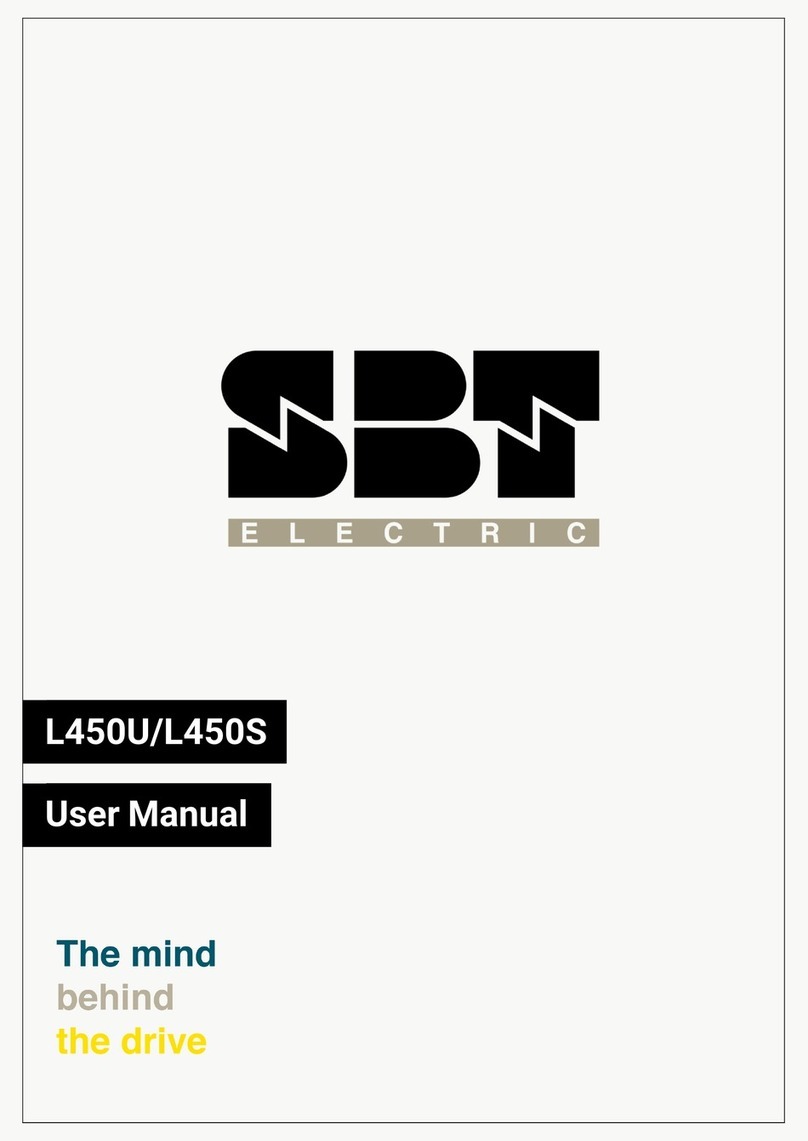
SBT
SBT L450U user manual

Kollmorgen
Kollmorgen AKD installation manual

Mitsubishi Electric
Mitsubishi Electric FR-F500 Series instruction manual
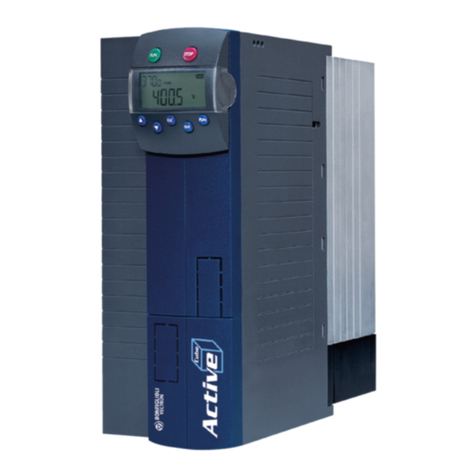
BONFIGLIOLI Vectron
BONFIGLIOLI Vectron ACTIVE CUBE manual

Trane
Trane TR1 6002-6004 installation instructions
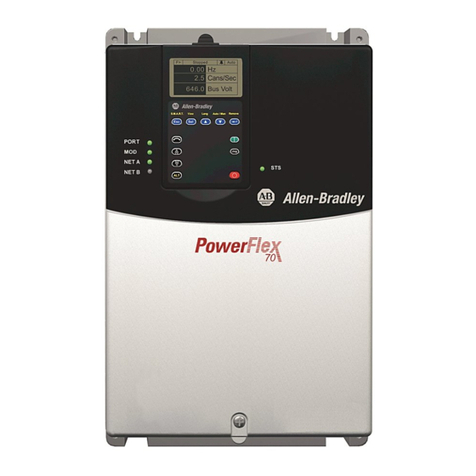
Allen-Bradley
Allen-Bradley PowerFlex 70 Quick start quide

